COBIE SMULDERS
MAKING A DIFFERENCE FOR CHILDREN IN CRISIS
VENICE’S SALT MARSHES: A NATURE-BASED SOLUTION
INDIGENOUS BRANDS THAT GIVE BACK

TOLD IN FILM FROM SPINAL CORD INJURY TO MOUNTAIN TOPS



MAKING A DIFFERENCE FOR CHILDREN IN CRISIS
VENICE’S SALT MARSHES: A NATURE-BASED SOLUTION
INDIGENOUS BRANDS THAT GIVE BACK

TOLD IN FILM FROM SPINAL CORD INJURY TO MOUNTAIN TOPS


RAYE MOCIOIU
For over a century, Save the Children has been at the forefront of the fight for children’s rights, ensuring that every child, no matter where they are, has the right to survive and thrive. It’s an important mission but by no means an easy one.
“Children around the world are growing up amidst endless difficulties: violence, climate change, poverty, food instability—it's daunting. This year alone, nearly 300 million people, including millions of children, will need urgent support,” explained Save the Children Ambassador and Canadian actress Cobie Smulders.
Known for her beloved roles in How I Met Your Mother and the Marvel Cinematic Universe, Smulders has been involved with Save the Children since 2018, actively contributing to the organization’s campaigns to support children and families in the U.S., Canada, and across the globe.
“I was introduced to Save the Children years ago through one of their local programs in the Los Angeles area that emphasizes early childhood education,” she said. “I’ve always been in awe of the phenomenal humanitarian aid efforts that Save the Children does globally and was thrilled to learn that their work extends to kids and families in my own community. I was so blown away by the life-changing impact that their early childhood education programs have on communities around the world and was eager to get involved—I feel so lucky to bolster the amazing work they do as an Ambassador.”
Save the Children has a long history of leading child-focused emergency responses around the world, and Smulders has been a steadfast supporter since joining forces with the organization. In 2023 alone, the organization helped over 9.3 million children in active conflict zones like Gaza, Ukraine, and Sudan, as well as in Afghanistan and Haiti, where humanitarian assistance is also desperately needed.
“Children in every country worldwide experience varying losses of fundamental human rights, as well as abuse, neglect, exploitation, and violence,” explained Smulders. “Save the Children prioritizes child protection in all its work, especially during crises and conflicts when children are most at risk.”
The organization works with governments, international organizations, and local community partners to implement protective laws and policies,
alter detrimental social and cultural practices, and improve communities' capacity to protect their children. From setting up emergency programs to delivering essential health services, educational materials, and psychosocial support, Save the Children addresses the many challenges children face.
“Save the Children’s approach to aid is community-focused and emphasizes local collaboration,” she explained. “Working together as a coalition, Save the Children and local community partners bridge the gap between the great work already being done locally and the urgent need for further support. I’ve been lucky enough to witness firsthand the impact that this sustainable approach to aid has on children and their communities, empowering communities to uplift themselves.”
“The power of an education is magical—but it isn’t a given for kids around the world,” said Smulders.
Education is a powerful tool that can lift girls out of poverty, allowing them to become exceptional women who change the course of their lives and communities. However, when a family faces financial hardship, often one of the first things sacrificed is a child’s education. Out of school, a child is more vulnerable to exploitation and violence.
Another of Smulders’ key focuses is supporting the education of girls through Save the Children’s "Gifts of Joy" campaign. Through this campaign, supporters can make life-changing contributions by gifting educational opportunities to girls in need.
“When you donate to Gifts of Joy, you bring hope, practical help and lasting change to children living in poverty and crisis. These gifts can save children’s lives, improve their livelihoods, and transform their futures,” she said.
The power of an education is magical—but it isn’t a given for kids around the world... for young girls, staying in school very often delays underage marriage and prepubescent childbirth, providing girls with an opportunity to choose their own path, become selfsufficient and pursue their dreams.
—Cobie Smulders
“Especially for young girls, staying in school very often delays underage marriage and prepubescent childbirth, providing girls with an opportunity to choose their own path, become self-sufficient and pursue their dreams,” she continued. Around the world, girls in conflict zones face heightened risks, from forced marriage to sexual and gender-based violence. For these girls, the impacts of conflict often remain unseen and unheard. Save the Children’s Girls in Crisis campaign seeks to bring visibility to their struggles and ensure their stories are told. Smulders has been a vocal advocate of this campaign, shedding light on the harsh realities faced by girls living in wartorn areas, where they are more likely to skip meals and be denied education.
COMFORT IN CRISIS
The COVID-19 pandemic upended the lives of millions of children, disrupting their education, healthcare, and overall well-being. The most vulnerable children, especially those in war zones, refugee camps, and remote Indigenous communities in Canada, were hit the hardest. Smulders joined Save the Children’s Save With Stories campaign, which aimed to raise funds to support children affected by the pandemic.
“Schools were shut down, and millions of kids worldwide were stuck at home without pivotal access to school lunches, books, and the daily resources many families depend on,” Smulders shared.
Save the Children’s #SAVEWITHSTORIES fundraising campaign, in collaboration with No Kid Hungry, partnered with athletes, musicians, actors, and other public figures to read stories online to engage kids in a great book and bring them a bit of joy.
“Over 100 stories were read to kids online; I read Lola the Lollipop Fairy by Tim Bugbird,” she said.
The Save with Stories fundraiser was a massive success—the proceeds allowed Save the Children to provide additional food and educational resources to children in hundreds of school communities nationwide. Shortly after her participation in Save with Stories, and inspired by the campaign, Smulders brought back her iconic How I Met Your Mother character, Robin Sparkles, to perform a quarantine-themed version of her hit song “Let's Go to the Mall.”
and created a COVID-themed version of ‘Let’s Go To The Mall,’ a song that my character’s Canadian pop star alter ego Robin Sparkles sang,” Smulders shared. “With the help of How I Met Your Mother creators Craig Thomas and Carter Bays, as well as genius composer Brian Kim, we called it ‘Let’s All Stay Home’ and shared it on socials, hoping it would bring people a bit of joy.”
More than just bringing joy to viewers, the playful parody fuelled donations for Save the Children, Canada Helps, and the Daily Bread Food Bank, supporting children and families struggling during the crisis.
“Anytime I visit a Save the Children program and have the chance to see the work in action, the need being met feels so critical,” said Smulders. “Whether it’s seeing families who struggle with food insecurity being supported by the organization’s hunger programs so that kids' bellies are full and they’re ready to learn or witnessing the generational impact that Save the Children’s early childhood education programs have on communities around the world—the work is critical and life-changing for kids and their families.”
There’s no shortage of crises and challenges facing kids and families worldwide. Children are at risk, whether from conflict, climate change, poverty or a combination of all those and more. Global hunger, too, adds to the issue.
Smulders shares that during the giving season, a time especially marked by meals with loved ones, her attention shifts towards Save the Children’s campaign to raise awareness of the hunger crisis.
“Towards the end of the year, we always focus on the growing hunger crisis that affects kids worldwide,” she said. "Kids can't learn, play, or dream on empty stomachs. That's why Save the Children is committed to helping fight food insecurity and ensuring that every child has the chance to thrive.
“Especially during the holiday season when many people would like to help but aren’t sure how—supporting global hunger is a tangible way to get involved with Save the Children programs and make an immediate difference in kids' lives.”
You can learn more about how you can help at savethechildren.ca/gifts



Bemaadizijig Ganoonindwaa
Talking to People

MARCI BECKING
In June 2024, the Anishinabek Nation launched a podcast that focuses on the territory's issues and initiatives. It is called Bemaadizijig Ganoonindwaa— Talking to People.

In the inaugural episode, podcast producer Lisa Abel of M’Chigeeng First Nation spoke with the Anishinabek Nation’s Anishinaabemowin Commissioner Barbara Nolan, originally from Wiikwemkoong Unceded Territory but now residing in Garden River First Nation, about what the name means.
“Bemaadizijig is people—those who are alive,” explained Commissioner Nolan, “Ganoonindwaa comes from Ganoonin—to speak to somebody.”
Since then, the podcast has touched on issues such as mining, Health Transformation, water, reconciliation, Anishinaabemowin revitalization, the Anishinabek Nation Child Well-Being Law, and coming soon, a look at anti-hate and anti-racism in the 2SLGBTQQIA+ community.
To share the podcast platform

with the Anishinabek Nation
2SLGBTQQIA+ Advisory Council is to amplify its voice, share what it does, and discuss the members' challenges and some of the issues they’ve encountered. The podcast is an opportunity to reach a much wider audience delivered dynamically.
These episodes will be featured
on the existing “De’aabshkoo Gdaawmi: We are all the Same” online education resource. This is a unique educational resource with Ontario Curriculum expectations built in while bringing to light First Nation peoples’ experience with racism. This resource helps fill the existing Indigenous education gap within the Ontario
Curriculum and helps teachers lead meaningful conversations with students that can extend beyond the classroom.
The goal of the 2SLGBTQQIA+ Advisory Council is to bring voices to the political forefront and ensure that all Anishinabek Nation citizens receive representation and support and have their voices heard.
There are currently three members on the 2SLGBTQQIA+ Advisory Council: NaWalka Geeshy Meegwun from Chippewas of Kettle and Stony Point First Nation, Heidi Whetung from Curve Lake First Nation, and Aaron Bowerman from Sheguiandah First Nation. The 2SLGBTQQIA+ Advisory Council is eager to hear the voices of 2SLGBTQQIA+ citizens of all ages within the Anishinabek Nation territory. Currently, there is a vacancy within the Northern Superior Region. If you or someone you know is interested in supporting this important work or for more information, please contact info@anishinabek.ca.
Bemaadizijig Ganoonindwaa will also feature an episode highlighting
work done around treaty education aired during Treaties Recognition Week in November.
Though the Anishinabek Nation continues to produce the Anishinabek News online news publication and many videos for its YouTube channel, as well as many public education resources available for purchase, free online teacher resources, and very active social media platforms, it was missing a place for Anishinaabe to talk about what is happening in the territory and educate people in a different way.
Bemaadizijig Ganoonindwaa— Talking to People can be listened to on all podcast platforms and the Anishinabek Nation YouTube channel. Listeners are encouraged to like and subscribe to the podcast!
The Anishinabek Nation is a political advocate for 39 member First Nations across Ontario, representing approximately 65,000 citizens. It is the oldest political organization in Ontario and can trace its roots back to the Confederacy of Three Fires, which existed long before European contact.
‘Tis the season for winter road trips filled with snowy landscapes and crisp, cool air. Whether you’re heading out to enjoy the wintry outdoors or relax in a cozy cabin, the roads are calling!
However, winter also comes with a specific set of hazards that all road-tripping travellers should keep in mind for a relaxing winter drive. Equip yourself with designed to provide better grip on snowy and icy roads, giving you increased control and safety. Sailun’s winter tire line-up, including the Ice Blazer WSTX, is engineered to excel in Canadian winter conditions. With features like V-shaped treads that reduce sliding and a unique rubber compound that stays flexible in cold temperatures, these tires ensure you’re ready for
to the waxy surface of the leaves, leading to a loss of traction.
Sailun’s winter tires, including the WST2 and WSL2, are designed to provide maximum traction in slippery conditions. These tires feature diagonal siping for better stability when braking and turning, ensuring that you maintain control, even when the roads are slick. Whether you’re




to be prepared for emergencies. An emergency car kit should include a first aid kit, blankets, jumper cables, and a basic tool kit. Adding road trip snacks can also keep spirits high if you find yourself stuck or delayed. With a well-prepared kit and the right tires, you’ll have peace of mind
Whether you’re driving through snowy mountains or icy city streets, Sailun has the right tire
your next winter road trip is as




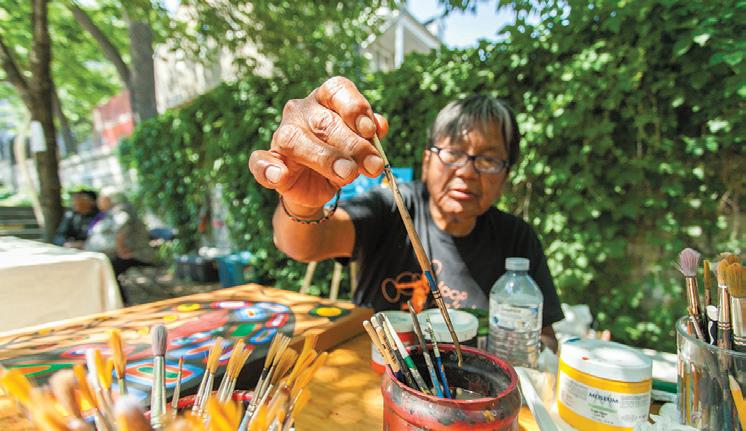
Sacred Fire Productions is a 12-year-old National not-forprofit Indigenous arts organization and a registered charity. Our primary mandate is to contribute to the cultural ecosystem to address the socioeconomic challenges and barriers Indigenous artists face. We have contributed to a better understanding of First Nations, Inuit, and Métis cultures through an approach that fosters intercultural exchange and dialogue. Honouring the role of artists as cultural leaders has been a guiding principle for our work.
Art is a universal language that unites members of every nation and territory. Art catalyzes people together, activates voices, makes them heard, and incites change. Since 2012, Sacred Fire Productions has worked with over 125 artists and has created space for over 90 productions, bringing 380,000 people together to view, hear, and feel the power of Indigenous stories through art.
“From the symbolism of clans to the personification of teachings, art expresses the land and the

stories we come from,” shared
Marlene Hale, Wet'suwet'en Elder and Honorary Board member of Sacred Fire Productions. “What a great platform to conversate with others about serious matters that impact Indigenous people, bringing light to stories about people and communities' stories and building legacies for generations to come.”
“Youth programs are important in our work,” said Hale. We are proud to be in our second year of Inspiring Dialogues, an art professional
development program that brings Indigenous artists and youths together in residency, followed by the creation of large-scale murals. This program engages youth and emerging artists in reconnecting with their ancestral heritage and cultural identities through art.
Like our ancestors, Indigenous artists continue to transmit our culture from generation to generation, which has always been at the heart of their resilience and identity. Indigenous art embodies deep creative stories,
political struggles, and environmental concerns where hope and resilience can be expressed. Indigenous artists share their values stemming from their creation stories, language, and cultural roots, paving the way to a better future for artists and their communities.
“We must be mindful of the global climatic changes that are affecting the Inuit, such as the melting of the polar ice caps, glaciers, and permafrost, which will eventually impact us all,” said Ulaayu Pilurtuut, an Inuit artist from Kuujjuaq participating in Nunaujunga, I am the Land, art exhibition produced and presented by Sacred Fire Productions in Montréal scheduled for Winter of 2025. "Inuit life has undergone a sudden shift in the last four decades, from nomadic subsistence hunting to permanent settlement in communities…It is important to redress the legacy of residential schools and advance reconciliation, bringing action to preserve Inuit women’s social fabric,” affirmed Ulaayu.

For many Indigenous artists, art is not seen as a commodity but as something akin to a family member—representing a multi-layered connection to the past, present, and future. Making space for Indigenous art to have life through creation embodies its people, culture, and history.
Learn more about Sacred Fire Productions and the importance of making Indigenous voices heard at sacredfireproductions.ca
RAYE MOCIOIU
Education is the cornerstone of a thriving society, empowering individuals to reach their full potential and contribute meaningfully to their communities. However, for many students in Jamaica, access to quality education remains a challenge—that’s where Helping Hands Jamaica comes in.
The Helping Hands Jamaica Foundation (HHJF) believes that every child deserves an equal opportunity to thrive academically, athletically, and personally. In the pursuit of this mission, the HHJF has pioneered groundbreaking programs aimed at empowering students and uplifting educational standards in Jamaica.
LIFE-CHANGING IMPACT
Principal Tanisha Thompson started teaching in her early 20s. Initially looking for a position as a cook, she began her career in education by filling in for a teacher on maternity leave. A motivator at heart, she found that teaching was a natural fit—she fell in love with teaching, furthering her own education at the same time.
For years, Thompson volunteered her services as a teacher. It was a difficult time, balancing the needs of the children she had come to love with the needs of her own family. With a dream of starting her own school and the motivation to make it happen, Thompson began reaching out to non-profit organizations to apply for a donor building, gathering funds and resources to bring the school to life.
With the full encouragement of parents who pledged their continued support, Goodwill Early Childhood Learning Centre started with only eight children, all under the age of six years old, in a shared building in the parish of Portland.
Thompson’s continued dedication paid off—inspired by her enthusiasm, HHJF connected with Thompson through their implementing partner, Food for the Poor. Marking the beginning of a fruitful partnership, Thompson was matched with a donor building, and HHJF became a pillar of support in the development of the school.
“It all paid off,” she explained.
“The donor building we got could not have been a better match—it

was fully furnished, with a sick bay, a kitchen, a store room. It was just amazing.”
Goodwill Early Childhood Learning Centre opened its doors on January 6th, 2022, thanks to the generous financial donation from Helping Hands Jamaica Foundation and in memory of founding board member Denise Jones.
As the school grew and developed, HHJF and Food for the Poor supported Principal Thompson and her staff, providing them with access to furniture, laptops, and food supplies. Time after time, the support has paid off—the ambitious school has since invited HHJF and Food for the Poor staff
members to attend Goodwill Early Childhood Learning Centre’s graduation ceremony, a milestone of its continued success.
"It's all about the children and serving our community and our people," said Principal Thompson. "That's what we are passionate about!"
THE PATH TO
EDUCATION
Central to HHJF's mission is the "Path to Education" fundraising stream, which aims to support primary schools in Jamaica, such as the Goodwill Early Childhood Learning Centre. In the wake of challenges exacerbated by the COVID-19 pandemic, including a
significant decline in literacy rates, the campaign seeks to revitalize education by improving infrastructure, providing technology resources, and fostering community engagement.
Building strong communities starts at the local level, and HHJF understands the power of extending these opportunities to the community. The "Adopt a School" campaign allows individuals, businesses, and volunteers to contribute to transforming education in Jamaica. By pledging financial support, businesses can become corporate partners, offering monetary assistance and valuable mentorship and internship opportunities. Similarly, volunteers can lend their time and expertise to renovation projects, workshops, and mentorship programs, making a tangible difference in the lives of students and the broader community.
The impact of these initiatives extends far beyond the classroom, creating a ripple effect of positive change throughout Jamaica. By investing in education, HHJF is not only unlocking the potential of individual students but also building a brighter future for generations to come.
Many of us learn as children about the food web, predators and prey, and the interconnectedness of the ecosystems around us. But we are now facing a biodiversity crisis that threatens to remove crucial strands of those webs, leading to the collapse of our ecosystems as we know them.
But there is a solution that is already proving successful—we just need to implement it.
Indigenous-managed land has some of the highest rates of biodiversity and conservation success; there is growing evidence in the scientific literature that Indigenous-managed lands are at least as effective as Canadian protected areas in resisting deforestation and ecological degradation. According to one recent comparative study, Indigenousmanaged lands in Australia, Brazil, and Canada host greater biodiversity than governmentmanaged protected areas or randomly selected non-protected areas. In Canada specifically, biodiversity is often equal or greater

in Indigenous-managed lands than in government-managed parks. In British Columbia, a governmentto-government partnership between Saulteau First Nation and West Moberly First Nation led to the development of the world’s most effective recovery program for endangered caribou. Unfortunately, not everyone recognizes these benefits. As a result, Indigenous Nations across Canada are taking Canada and the
provinces to court to fight for their territories and their rights. As these Nations gain control of their territories, they are able to implement the land management practices that we need to protect biodiversity. These include Nations like the Heiltsuk Nation, who are challenging the failure of the regulatory system to provide compensation and resto ration for an oil spill that devastated their coastline and the plants and animals that called it home; the
Gitxaała Nation, which is seeking to have British Columbia uphold the promises it made to implement the United Nations Declaration on the Rights of Indigenous Peoples, which will help them continue taking the steps needed to protect their territory; and Beaver Lake Cree Nation who are arguing that Treaty No. 6 and their rights have been rendered meaningless because of Canada and Alberta’s failure to consider the cumulative impacts that industry has on their land.
With each of these legal challenges—and the others RAVEN supports—Nations are moving one step closer to being able to govern and manage their territories in ways that protect biodiversity. RAVEN fundraises to support Nations facing governments and corporations in court because, without this financial
ecosystems, dwindling biodiversity, and additional effects of the climate crisis.
An Indigenous-led organization, RAVEN is the only charity in Canada with a mission to assist Indigenous Nations with funds to protect their rights and territories in court. Thanks to thousands of monthly supporters and donors committed to providing access to justice for Indigenous Nations, RAVEN has raised over 22 million dollars since 2010 for Nations whose legal victories have protected sacred lands, upheld Indigenous rights, stopped pipelines, defended the land from open-pit mining, and set powerful precedents for future generations. Indigenous nations are protecting the land and environment for themselves and for all of us. Will you join them?




Think self-care is just another trend? Think again. The Sheen for She Foundation is proving that self-care isn't just talk—it's a life-saving tool for confronting the aftermath of domestic violence and making life's hurdles a little easier to overcome.
As the epidemic of violence against women escalates at an alarming rate in our communities, Sheen for She is implementing a widely overlooked strategy—empowering women to take charge of their health through self-care. This multidimensional approach doesn’t just cut down on unexpected medical visits; it creates opportunities for women to build lasting habits of self-love and personal responsibility, ultimately fostering both physical and emotional well-being.
After escaping a long history of violence, Addison, a client of Sheen for She, shared, "For the first time in years, I felt love and respect for the woman I am—something I lost during my relationship."
Since the COVID-19 pandemic, the Sheen for She Foundation
has distributed more than 15,000 Perseverance Aid Kits (PAKs) to women and youth across the GTA and rural Ontario, providing vital support where it’s needed most. By partnering with over 80 women’s organizations and shelters, the foundation has made a measurable impact—helping to
reduce violence, alleviate anxiety, and empower women to regain control of their lives. The success of the Perseverance Aid Project is just one example of the many programs at Sheen for She that highlight the transformative power of self-care, backed by evidence-based results.

A staff member from the Scarborough Health Network’s Sexual Assault and Domestic Violence Care Centre commented, “As you know, many of the clients that we see have just gone through something traumatic. Being able to use Sheen for She’s items to shower and freshen up after the assessment and Sexual Assault Evidence Kit has made a huge difference in their care.”
A growing team at Sheen for She powers a variety of programs, including crisis counselling, medical esthetics, self-defence workshops, legal system navigation, and transitional personal healthcare programming.
Eve, a dedicated volunteer with the Sheen for She Foundation for several years, shared her reflections on the experience: “Volunteering with Sheen for She has given me the chance to give back and is so important to me as a single mother. Hearing the stories of the women we've helped reminds me of the importance of self-love. I always tell my daughter that real
strength starts with loving yourself, and if she can hold on to that, nothing can stop her.”
“The urgency of self-care is undeniable. It's incredible to witness the immediate and lasting changes that occur when a woman takes crucial steps to protect her well-being, her family, and her identity. Self-care empowers women to build a stronger relationship with themselves, understand their needs, and navigate life's challenges with grace. At Sheen for She, we support women as they rebuild their lives, reinforcing that their experience of violence does not mark the end of their life story,” stated Mary Hawk, CEO of the Sheen for She Foundation.
Visit sheenforshefoundation. com to learn more about how you can support this lifechanging work. You can also find Sheen for She on Instagram, Facebook, and YouTube @sheenforshe and @sheenforshefoundation.
For most of us, sight is something we take for granted. We can’t imagine not opening our eyes and letting the world in. For most of us, eye care is readily available when we need it. But globally, an estimated 43 million people are blind. Forty-three million people can’t see the faces of their loved ones, sunsets, or roads to explore. And while the number 43 million is hard to look at, here’s another that will open your eyes: 36 million people who are blind don’t have to be. Because 80 per cent of all blindness is either treatable or preventable. Four out of five people who can’t see could regain their sight with
proper medical care.
But the most crucial factor is that your ability to see actually has nothing to do with your eyes. It’s where you live. Ninety per cent of all people who are blind live in low- and middle-income countries, places without access to proper eye care and medical facilities. And that’s a missing piece in the world that Vancouver-based Seva Canada is trying to fill. Seva Canada is a global, non-profit eye care organization committed to treating and preventing vision loss in low-and middle-income countries. The ability to see, connect, work, and live independently should not be determined by
where you live. To date, Seva donors have restored vision to over five million people, transforming countless lives.
Right now, Seva Canada’s “Love at First Sight” campaign is launching across Canada. This campaign is not about numbers, stats, and stories of pity. It’s about empowerment. It is an uplifting, human campaign that allows all of us to share the joy a patient feels when their sight is restored. Earlier this year, Seva Canada staff travelled to Nepal and India and provided cameras to patients who had just had vision-restoring surgery. Our request was simple: we asked patients to document their initial experience
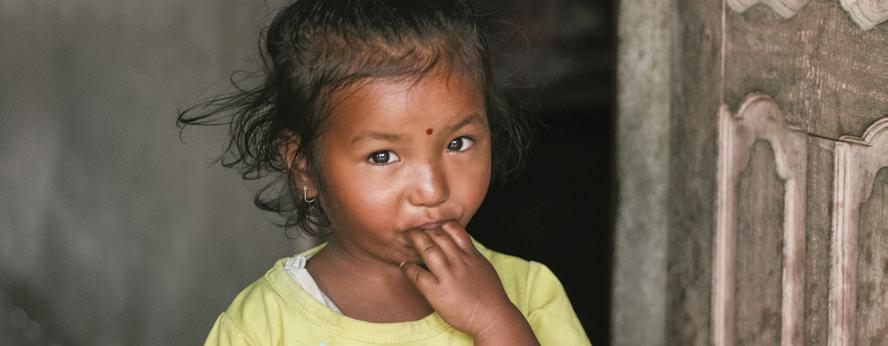
When you look at me, what do you see? This is a question that resonates deeply within the facial difference community.
Despite including relatively common conditions such as cleft lip and palate and Bell’s palsy, facial differences remain widely misunderstood. People with facial differences continue to regularly encounter barriers and misconceptions in a world that is still learning to see beyond the surface.
Facial differences can be congenital (conditions or syndromes from birth); episodic (coming and going, such as acne or other skin conditions); or acquired (including from accidents, burns or illness).
While the language has thankfully moved away from terms such as “deformity” or “disfigurement,” a shift in language is just one part of the larger issue. People with facial differences remain underrepresented and often excluded from workplace and human rights protections.
But the movement for change is gaining steam. AboutFace, a national charity, works with a network of volunteers across the country to build inclusive spaces and promote greater equity for the facial difference community.
KELSEY’S STORY: AMPLIFYING IMPORTANT VOICES
Kelsey, Communications Officer at AboutFace, was born with Moebius syndrome, a condition
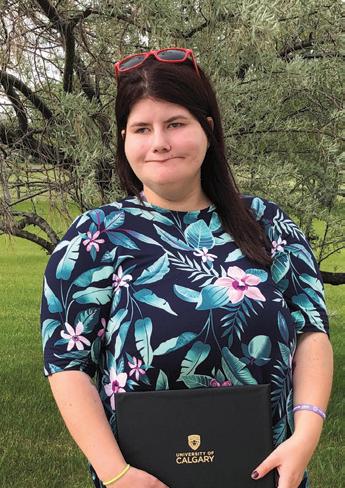
of seeing the world anew. When the bandages came off, the world came in. And our cameras captured some of what they saw. Family, faces, and communities filled the eyes of these patients. As did tears of joy. Seva Canada is sharing those images to hopefully make the world take notice of how little it takes to make such a big difference in someone’s life. A simple $50 donation restores sight with a 15-minute cataract surgery. Even a $5 donation supplies prescription glasses to patients of all ages, especially children who long to see their mother’s face instead of just hearing her voice. When you restore someone’s vision, you are not just changing one life; you are
changing all the lives around that person, impacting everyone who cares for them.
The “Love at First Sight” campaign is designed not just to show you what patients see when they first open their eyes but also to show everyone how little it takes to make a life-changing difference for someone who is blind simply because of where they were born. That’s both fundamentally unfair and within our power to correct. For most of us, vision is a gift. This campaign is our chance to give it.
Learn more at seva.ca/LoveAtFirstSight
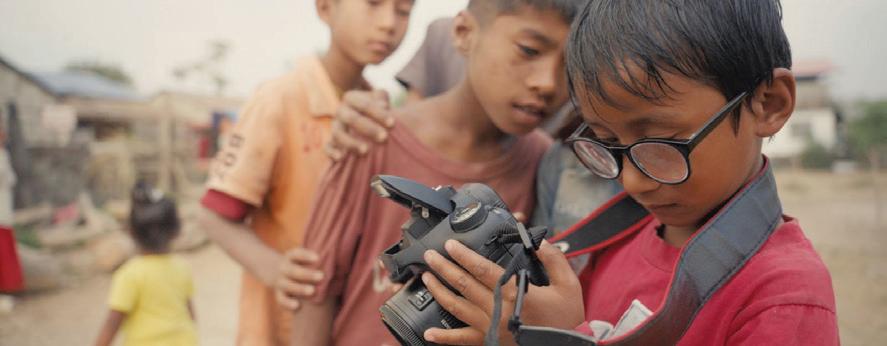
causing facial paralysis, among other complications. She has a lifetime of experience with the reactions of others. “People whisper, stare, or ask intrusive questions like, ‘what’s wrong with your face?’” she shared.
Despite Kelsey’s master’s degree, misconceptions about her abilities are a recurring theme. Growing up, her teachers often didn’t know the best way to support her and would assume she had a cognitive disability. Even if perfect on paper for a job, interviewers often can’t hide their surprise when she walks into the room.
Navigating a world filled with roadblocks has shaped Kelsey’s passion for advocacy. She went into communications because “I feel like the stories of people with differences aren’t told enough. Social media is a powerful platform to introduce voices from this lesser-known community,” she said.
ALEC’S STORY: THE POWER OF COMMUNITY
At 12 years old, Alec is already making a big impact as a member

of AboutFace’s Youth Advisory Committee. Alec has Goldenhar syndrome, a congenital condition characterized by abnormal development of the eye, ear and spine.
Alec attends Camp Trailblazers, which operates in several provinces thanks to camp partnerships and the AboutFace Training & Camp Bursary Fund.
Connecting with kids who have varying conditions but who share the unique challenges—both medical and emotional—of growing up with a facial difference has been a
game-changer for Alec.
“It was a revelation to meet so many others with facial differences,” said Alec’s mother. Alec quickly corrected her: “I think you mean revolution.” And perhaps he’s right.
A PATH TO BREAKING THE STIGMA: EDUCATION AND ADVOCACY
Recognizing that education is key, AboutFace has an ever-expanding library of resources and educational programs for the facial difference community and their families, as well as for organizations and the broader public.
“Support for the facial difference community goes beyond telling people to just ‘be kind,’” said Kelsey. “It’s about implementing tangible policies and procedures to protect rights and ensure equal access to opportunities. And it’s about education, because education leads to understanding and acceptance.”
Learn more and get involved at aboutface.ca

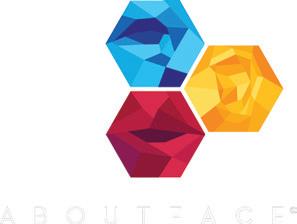

You are out and about, and suddenly, you urgently need to use the bathroom. It is a race against the clock to find the closest one.
While we have all experienced this, what if you were at risk of feeling an urgent need for a washroom every time you left home?
That urgency is one of the realities of living with Crohn’s disease or ulcerative colitis, the two most common forms of inflammatory bowel disease. People with these diseases may need to use a washroom up to 20 times a day.
Today, these diseases have no cures. Crohn’s and colitis can cause severe diarrhea, constipation, fever, rectal bleeding and blood in the stool, unrelenting abdominal pain and cramps, weight loss, fatigue, and sleep problems. Treatment options are limited and may stop working over time. Surgery to remove part of the intestines is a frequent need.
The anxiety of an accident due to an urgent need to go to the washroom leads many of the 322,000+ people in Canada living with Crohn’s or colitis to stay home. When they do go out,
they often plan their activities and route around publicly accessible washroom locations.
The GoHere app from Crohn’s and Colitis Canada is designed to make lives easier for people with Crohn’s and colitis by helping locate nearby washrooms. This free app was launched in 2015 and has been downloaded 46,000 times. It has a database of more than 3,600 publicly available washroom locations.
GoHere shows the nearest available washrooms to your current location. You can also map a route and see the location of washrooms along the way. The locations of the listed washrooms have been shown almost 2.5 million times.
GoHere reduces the stress and anxiety associated with managing urgent bowel symptoms while in public, something that Justine Giguère of Montréal knows first-hand. Diagnosed with colitis at the age of 23 in 2021, she discovered the GoHere app and began using it to find out where she could go in case of emergency.
In 2023, she started a new
role as a sales representative for L’ORÉAL, which requires her to be on the road five days a week to visit clients on the south shore of Montréal. She was stressed at the thought of being on the road for appointments and suddenly needing to go to the washroom—especially when her colitis acted up and created an urgent need for a bowel movement. The solution: the GoHere app.
Justine said, “Initially, I would skip meals on the road so as not to worry about needing a washroom. With GoHere, my stress is reduced; I can eat and not worry. Even if I have a flare, I can still go out because I have a solution to manage an urgent need for a bathroom. It’s great to know that I can use the bathroom in participating stores without buying anything because they’re part of GoHere. It’s a quick, no-questions-asked solution.”
The GoHere app is free and available for iPhone and Android devices. Learn more
Prince William is set to appear in a new TV documentary series about his homelessness programme, Homewards. With his ambitious initiative, the future British king wants to end rough sleeping, sofa surfing, and other forms of temporary accommodation associated with homelessness.
Homewards is a five-year project launched by William in 2023 to bring together a range of individuals and organizations to develop bespoke homelessness solutions in Newport, South Wales, Poole, Bournemouth, Christchurch, the south London Borough of Lambeth, Belfast, Aberdeen, and Sheffield. It’s a joint effort between the public, private, and charity sectors to identify the causes of homelessness and make headway toward eradicating it in five years.
Marking the first year of his Homewards campaign to eradicate homelessness, Prince William will report its progress in building community links to make it a "rare, brief and unrepeated" experience.
The two-part series, Prince William: We Can End
Homelessness scenes of the first year of the Homewards programme.
It will follow the Prince of Wales as he launches Homewards across the UK and will feature the journeys of those currently facing homelessness or who have lived experience of the issue. To delve into these experiences, Prince William recently invited members of the public who have had "lived experience" of homelessness to Windsor to hear more about what needs to be done to help.
The documentary will also feature well-known advocates of the programme, alongside those leading individual projects across the UK.


Jo Clinton-Davis, controller of facts at ITV, said, "With access to the inner workings of this ambitious project and the work of Prince William and his team, we hope to share with viewers a privileged insight into how they are setting out to tackle an issue which concerns us all and affects so many of our fellow citizens across the UK."
William has long been passionate about the issue of homelessness. He
for West Sussex Fire and Rescue Service, is one of the advocates working with Homewards and praised William for his empathy.
She said: “He understands trauma, he does understand trauma. He can see echoes of it in himself, I think, from that experience of trauma and how it affects you and how it affects the way you see things.”
The TV show will air in the UK later this year.
(Source: Reuters)
New drugs and treatments can be a patient’s last hope. Right now, fewer than 20% of new global treatments are available through public drug plans in Canada.
Together, we can cut the red tape, save lives, and provide hope when it matters most.
John Butcher spent 37 years as a paramedic for the City of Toronto, providing emergency care and transportation to people across the city. Throughout his years of service, John had completed a few patient transports to UHN-West Park Healthcare Centre but never imagined that he would become a patient there one day.
Struck with Guillain-Barré Syndrome in the summer of 2022, a rare disorder in which the body’s immune system attacks the nervous system, John found himself a patient of the medical system he had spent years working in.
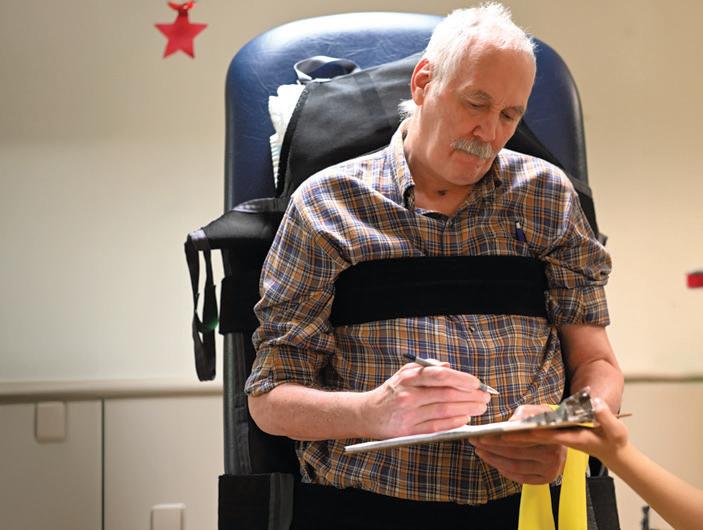
What began as tingling and numbness in his extremities devolved into total paralysis of his entire body below the neck within six weeks. The syndrome also caused immense pain in the paralyzed parts of his body.
While there is no cure for Guillain-Barré Syndrome, treatments can help improve symptoms and shorten the duration of the illness. Most patients notice improvement within days to weeks, but some—like John— take significantly longer. He arrived at West Park in December 2022 on a ventilator and feeding tube, and his recovery journey began.
Physical therapists moved and manipulated his joints to prevent them from seizing up and to prepare them to move again independently while clinicians worked on pain management strategies and treatments.
One day in January, John’s shoulder “felt funny,” and he was able to move it slightly. From there, functionality came
back “like a waterfall,” moving down his body and into his hands, albeit slowly.
Each month saw an exciting new milestone—drinking from a cup, breathing on his own for 15 minutes, moving off the ventilator entirely, and lifting his elbows. The staff celebrated these milestones with John, with the nurses making sure to wave when they saw him to encourage him to wave back—something he hadn’t been able to do.
“He’s re-learning skills in a modified way. For us, the small wins, like holding a pen or waving, are the big wins, the great wins,” said Donna Espiritu, Clinical Service Manager.
John is now able to breathe on his own and feed himself, but he still has months of therapy ahead of him.
He says he owes the speed of his recovery to the staff.
“When I started to show signs of improvement they encouraged and assisted me. They had to deal with my severe pain and did so with compassion. My recovery
time has been reduced by the excellent treatment at West Park," John said.
Learn more at WestParkFoundation.ca
UHN-West Park Healthcare Centre is a national leader in rehabilitation and complex care, helping people recover from severe injury or illness and get their lives back.
Our physicians and therapists work with patients to help them achieve their recovery goals, which often involve the everyday tasks, such as safely cooking a meal, that are essential to a life of independence.
On November 2, join us for the ultimate foodie experience at the West Park Foundation Culinary Showdown, when we will be raising money to support one of the Activities of Daily Living suites at West Park, where patients relearn the vital skills they need to live independently.



For three decades, Sleep Country has been a force for good in Canada—and it all started with a small idea and a big dream.
In 1994, Sleep Country opened its doors with just four storefronts, laying the foundation for what would become a national leader in sleep retail. Today, Sleep Country has 306 corporate-owned stores and 18 warehouses, but it's better known for the meaningful impact it has made in communities across the country.
Even more important than building a national brand is building trust within communities across the country, and over the last three decades, Sleep Country has made it a priority to give back. Their impact spans communities of every scale—from providing beds for the athletes in the Olympic Village during the 2010 Vancouver Winter Olympics to donating over $720,000 worth of sleep essentials to help families displaced by the devastation in Ukraine.
In fact, since 2004, the company has donated over 972,000 mattresses to those in need—almost enough to support the entire population of Ottawa! This impressive statistic is part of Sleep Country’s plan to tackle furniture poverty, a mission shared
with one of their charitable partners, Furniture Bank. Furniture poverty, while often invisible, has significant physical, emotional, and financial impacts on vulnerable communities. By redistributing gently used furniture and household items, Sleep Country and Furniture Bank give families and individuals in need the opportunity to furnish their homes. From supportive and comfortable places to rest their heads at night to furnishings that support gatherings, it’s a tangible solution to an invisible problem.
To make a good thing better, it’s a win-win partnership—in addition to promoting well-being and stability for those most in need, this initiative also diverts mattresses from landfills, giving them a second life and a greater purpose.
A mattress is an impactful purchase, and at Sleep Country, the impact goes beyond a good night’s sleep. Over time, mattresses can wear out, sag, and cause discomfort. On average, mattresses should be replaced every six to eight years—that’s a lot of mattresses being discarded each year.
Sleep Country cares equally about both awakening Canadians to the power of sleep, as well as caring for the planet. That’s why, since 2004, Sleep Country has diverted over 2.9 million mattresses from landfills—the height of 1,600 CN Towers stacked on top of each other. And their work is far from over: By 2040, Sleep Country aims to achieve net-zero greenhouse gas (GHG) emissions, strengthening their commitment to creating positive and sustainable change.
In its mission to combat climate change, Sleep Country introduced the Green Glove Delivery program, which not only focuses on responsible mattress recycling but also extends to proactive tree-planting initiatives. The Green Glove service is Sleep Country’s premium delivery service, where delivery teams fully assemble and set up new mattresses and beds for customers. Sleep Country also takes back customers’ previously used mattresses, bed frames, and box springs, and removes all packaging materials, recycling them responsibly back at its distribution centres. But there’s more to the Green Glove program than innovative recycling practices. For every mattress recycled, Sleep Country plants a tree—so while you sleep, you’re also contributing to restoring ecosystems and making a tangible difference in the fight against climate change.
Teaming up with Veritree, a climate tech enterprise, Sleep Country aims to plant 150,000 trees in Canadian regions ravaged by wildfires, particularly in British Columbia's Cariboo region. That would take up the space of about 29 football fields! Operating within the Tsilhqot’in First Nation, Sleep Country has enlisted the help of local Indigenous tree planters, demonstrating a deep respect for the land and the people who know it best.
This milestone initiative has an impressive impact: 150,000 matured trees are expected to sequester an average of about 32,000 metric tons of carbon dioxide, comparable to removing nearly 7,000 cars from the road for a year. Already, a good night’s sleep is paying off tenfold.



In a secondary school workshop, a dedicated technical educator works tirelessly to ignite passion and equip students with skills vital to the skilled trades industry. However, their potential may remain untapped without proper support—a scenario more common than realized.
Technical education is essential for bridging the skilled trades labour gap and promoting economic growth. The shortage of skilled trades professionals is influenced by factors such as limited awareness, funding challenges, and the need for modernized training. Comprehensive support for
technical education is necessary to build and sustain a skilled and dynamic workforce.
The Ontario Government’s new technological education credit is a promising initiative aimed at reducing these barriers and helping technical education by offering financial incentives to students. However, this must be complemented with broader support to be truly effective.
Technical education needs qualified technical educators in secondary schools. Continuous professional
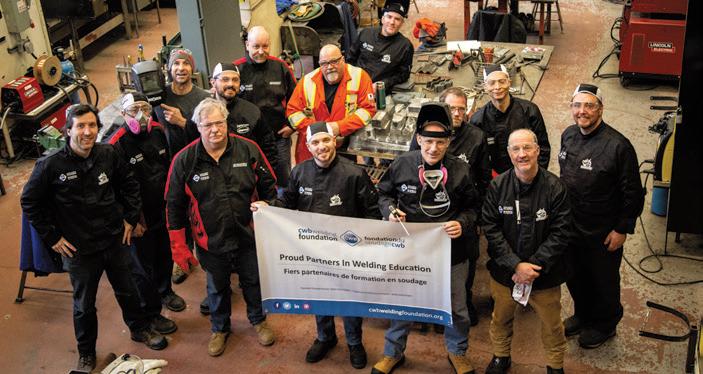
development is the best way to ensure educators can integrate the latest technological advancements and teachings into their classrooms, enhancing students' employability and confidence.
These passionate and well-informed educators inspire and motivate students, sparking interest in technical careers. Educators keep learning exciting and relevant by providing relatable and practical industry examples.
Providing education for proper safety equipment use and well-maintained workspaces also creates much-needed educational support and training. Programs like the CWB WeldSAFETM grant emphasize safety protocols and foster a safe learning environment. Learning how to maintain personal protective equipment (PPE) and ensuring all tools are in good working order in classrooms instill a culture of safety that students carry into their professional lives.
A robust curriculum combining theoretical knowledge with practical skills is also vital. Continuous updates to the curriculum keep pace with industry advancements, ensuring students are
well-prepared for their careers. The CWB Foundation funds access to online curriculum resources, enhancing in-class learning. Collaboration with industry further ensures content remains relevant, incorporating emerging technologies and up-to-date practices. At the end of the day, adequate funding remains the backbone of successful technical education programming. According to a recent survey done by the CWB Foundation of Technical Educators, funding is the primary obstacle preventing the expansion of welding programs. Financial resources, like the CWB Capital Equipment and Consumables grant, are necessary for up-to-date tools, safety equipment, and consumable materials, ensuring students receive hands-on learning in an industry-relevant and safe environment. Schools also need sufficient budgets to maintain and upgrade equipment. Without funding, schools struggle to provide the practical experience future employers seek, hindering students' readiness for the workforce.
BRIDGES THE GAP
Engaging employers, unions, and organizations is crucial for the success of technical education. These stakeholders provide valuable resources, insights, and opportunities for students. Partnerships with industry stakeholders ensure programs remain relevant to workforce demands. Employers offering apprenticeships, unions advocating for quality training, and organizations contributing resources create a symbiotic relationship that enhances educational experiences and improves employment outcomes. Comprehensive support for technical education is key to addressing labour shortages and investing in our future workforce and economy. By working together to fund programs, ensure safety, update curriculums, and foster industry partnerships, we can build a strong foundation for the future workforce. Partner with us to support and invest in technical education by visiting cwbweldingfoundation.org/ partnering-for-a-stronger-future
Creating inclusive and safe environments is more important than ever in our increasingly diverse world. But can we ensure that our workplaces and communities feel welcoming and accessible to others?
The Safer Spaces initiative, led by the Gilbert Centre, simplifies things. The Gilbert Centre plays a crucial role in supporting marginalized communities and those impacted by HIV and Hepatitis C, including 2S-LGBTQ+ individuals and families.
Safer Spaces provides live professional development workshops and self-guided online training modules to foster inclusivity and safety in various settings. By supporting marginalized communities, encouraging
unmet needs. Additionally, the mental health of 2S-LGBTQ+ individuals is disproportionately impacted by stigma, prejudice, and discrimination, resulting in higher rates of depression, anxiety, and suicide. This tells us that despite progress, many 2S-LGBTQ+ individuals still face significant challenges in feeling accepted and included in their communities, chosen and otherwise.
The Safer Spaces campaign aims to change this, and it begins with training. After all, how can we make changes if we don’t know what needs to be changed? In every setting they work in, Safer Spaces opens up new perspectives so every participant feels seen, understood,
2S-LGBTQ+ individuals by tackling institutional barriers to inclusion.
The results are tangible at every level. Workshops equip participants with concrete strategies to enhance their work and foster a more inclusive environment, and management is guided through best practices to create a workplace culture that prioritizes inclusivity.
THE BENEFITS OF SAFER SPACES TRAINING
With over 300 organizations engaged, more than 550 workshops delivered, and over 13,000 individuals trained, Safer Spaces has made a significant impact on the organizations that have benefitted from its training programs. The

BENEFITS FOR YOUR EMPLOYEES
the program can proudly display Safer Spaces posters and stickers, signalling their commitment to 2S-LGBTQ+ communities and becoming inclusivity leaders in





“It feels unbelievable because I’ve never really won anything in my life,” said Chandra (Nat) Limiarja. That was the reaction of the Humber Polytechnic Research Analyst student following his victory at the national Map the System competition for his presentation Breaking the Cycle of
Hate: A Systems Analysis of AntiLGBTQ Sentiment in Indonesia Limiarja, who’s originally from Indonesia and is gay, said this was his first opportunity to conduct research in areas that touched on mental health and the LGBTQ+ community. Map the System is a global competition run by

Oxford University that tasks students with addressing global issues by studying them to gain a deeper understanding of the problem, its broader context, and how it connects to other problems, a process known as systems thinking.
Humber Polytechnic has embedded employability experiences that bring the lessons taught in the classroom into the real world. By emphasizing instilling the skills and values that will enhance students’ employability, Humber ensures students’ resilience and competitive edge in the face of evolving labour markets.
“Humber Polytechnic is committed to building lifelong employability for its students through hands-on opportunities that apply their knowledge and skills inside and outside of the classroom,” said Ann Marie Vaughan, president and CEO of Humber Polytechnic. “By reimagining education to adapt to and shape the changing world, Humber will equip graduates for success and empower them
to make a positive impact.”
Following his win, Limiarja said he hopes to make a social impact in his future career and that his participation in the Map the System competition opened his eyes further to this possibility.
Although being part of the LGBTQ+ community isn’t illegal in Indonesia, Limiarja said there are laws on the books that are being used to implicitly criminalize them, with new laws being added that are used against the LGBTQ+ community. The government, media and religious groups also push widespread anti-LGBTQ+ sentiments and campaigns.
“It really hurt me when I was doing the research and I didn't expect it to impact me so strongly,” said Limiarja. “But it really pushed me to focus on what I can do because I want to help and create change.”
Equipping students with the tools to go out into the world and create positive change is one of the tenets of Humber’s mission
to develop broadly educated, highly skilled, and adaptable citizens. It speaks to Humber’s recently released vision for the future, Building Brilliance. Limiarja's research instilled in him a sense of hope for the future. He initially thought that LGBTQ issues didn’t resonate with Indonesians. However, he found many activists lobbying politicians for change and grassroots organizations providing support. His proposed solution to LGBTQ discrimination in Indonesia is increased advocacy and support for activists working to have the country’s legal code revised.
The judges recognized his thorough research and systems thinking approach. “When I heard them call Humber, my jaw dropped. I still can’t believe it. It’s such a good feeling to see all that hard work being acknowledged.”
Learn more about Building Brilliance at humber.ca/building-brilliance
MURRAY
ALLIE
In a world where conscious consumerism is on the rise, Indigenous brands are leading the way by offering products that are not only rooted in tradition, but also dedicated to giving back to their communities. These three Indigenous brands are making a difference by preserving cultural heritage, giving back to local initiatives, supporting causes near and dear to their heart, and so much more.
MINI TIPI
Operating out of Gatineau, Québec, MINI TIPI is on a mission to address the lack of authentic Indigenous-designed textiles. While celebrating Indigenous arts and culture, co-founders Trisha Pitura, a member of Nipissing First Nation, and Melanie Bernard, from Québec City of settler descent, are dedicated to lifting up Indigenous artisans, while giving back to Indigenous organizations and charities across Canada.
MINI TIPI not only donates
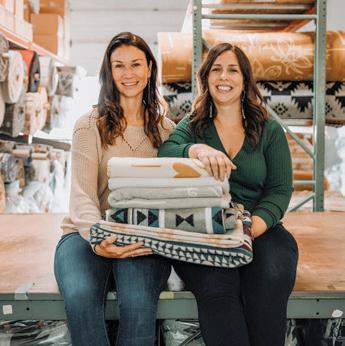
products to Indigenous communities, but they raise money through a portion of their sales to provide monetary support to organizations like the Downie-Wenjack Foundation, the Minwwashin Lodge, the Aylmer Food Bank, and many more.
Some of their products are even fundraisers in their own right—three of their blankets have a built-in give back, with proceeds of every sale going towards True North Aid, an Indigenous organization that supports northern and remote communities with humanitarian support.

KOKOM SCRUNCHIES
When Mya was nine years old, she founded Kokom Scrunchies, a family-run business selling handmade scrunchies. From Kitigan Zibi Anishinabeg First Nation, Mya began sewing scrunchies to make money so she could buy gifts for children in her community, which later became an online business selling her handmade goods. While Kokom Scrunchies initially began as a solo venture, Mya soon had to enlist the help of her mom, dad, and brother to help as demand grew.

Each scrunchie was named after an Indigenous role model in her life—even the brand name itself, Kokom, which means grandmother in Algonquin. Seeing the demand for her products, Mya expanded the company to offer scarves, t-shirts, bags, textiles, and much more. She later launched Canada’s first-ever Kokom Scrunchies vending machine, located in Ottawa’s Bayshore Shopping Centre, with a second one opening in the New Sudbury Shopping Centre in Sudbury, Ont.
In January 2015, Jenn Harper had a dream of young Indigenous girls covered in colourful lip glosses— this dream is what inspired her to launch one of the first Indigenousowned cosmetics companies: Cheekbone Beauty. More than makeup, Cheekbone is dedicated to making the cosmetics industry a place where everyone can feel included, especially Indigenous peoples. Every shade of lipstick is named after an Indigenous woman working to make a difference in their community, some of which being Ashley Callingbull, the first Canadian and first Indigenous woman to win the Mrs. Universe title, and water activist and youth hero Autumn Peltier. Similarly, Cheekbone Beauty gives back to Indigenous youth across Canada through the Cheekbone Beauty Scholarship Fund. The funds for the scholarship are raised through a limited-edition product, where 100 per cent of the sales are allocated towards funding next year’s scholarship.
For many Canadians, a night out at a restaurant or a weekend stay at a hotel is a chance to unwind and create lasting memories. However, the reality can be far from relaxing for the workers behind the scenes in the hospitality industry. This sector, a vital part of our economy serving nearly 22 million Canadians daily, is facing a hidden crisis: a mental health and substance use epidemic. Long hours, demanding schedules, and financial strain have taken a toll on hospitality workers. The pressure to deliver exceptional service in fast-paced environments can be immense, often with understaffing and challenging circumstances. A staggering 87 per cent of front-line food and beverage staff report experiencing burnout, with depression and anxiety affecting 77 per cent and 84 per cent, respectively. These numbers are alarming, highlighting a crisis simmering beneath the surface of our vibrant hospitality scene.
Despite these alarming figures, only 38 per cent of hospitality workers seek professional help, often due to cost. Mental health services can be expensive, and
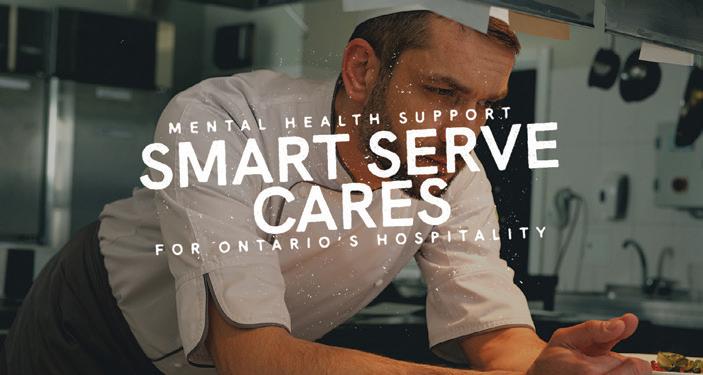
many hospitality jobs lack robust benefits packages. Financial constraints become a barrier, forcing workers to suffer in silence, impacting their personal lives and work performance. The pandemic undoubtedly exacerbated these issues. However, the root causes run deeper. Irregular hours and disrupted sleep patterns impact physical and mental health. Many hospitality businesses lack sufficient employee benefits, including mental health support. This creates a culture of silence, where employees feel discouraged from seeking help, especially due to cost concerns. There's finally some good
news for our servers, bartenders, and hospitality staff. Smart Serve Ontario, a registered charity dedicated to responsible liquor sales and service practices, launched a groundbreaking campaign, Smart Serve Cares. Partnering with mental health experts Not 9 to 5 and GreenShield, Smart Serve Cares offers free mental health resources to all Smart Serve certificate holders, reaching over 550,000 individuals. Recognizing the unique needs of hospitality workers, the campaign offers a comprehensive suite of resources:
• Free Virtual Counselling: Access to three hours of virtual counselling sessions with qualified
therapists. These sessions can help workers address specific challenges, develop coping mechanisms, and improve their overall well-being.
• Digital CBT Programs: The campaign provides access to GreenShield's online cognitive behavioural therapy (CBT) programs for those who prefer a self-guided approach.
• Digital Mental Health Resources: GreenShield+ will provide access to a wealth of digital mental health resources, including articles, videos, and online communities.
This initiative is a lifeline for an industry in crisis. Investing in mental health isn't just about helping individuals—it's about building a stronger hospitality sector. Studies by Deloitte show companies with mental health programs for workers experience a significant return on investment. Imagine a hospitality industry where staff feel supported, valued, and empowered to prioritize their well-being. This creates a ripple effect—better service, happier employees, and a thriving industry.
Smart Serve Cares is a beacon
of hope, showing the industry is taking mental health seriously. However, it's crucial to recognize this is just one step on a longer journey. This campaign serves as a call to action for the sector to follow suit and invest in their employees' well-being.
Employers have a crucial role to play. Creating a culture of mental health awareness and providing resources can make a significant difference. This can include offering access to and promoting mental health resources and fostering open communication about mental health challenges. By working together—employers, workers, and mental health advocates—we can address the challenges facing the hospitality industry and ultimately create a culture of support.
The hospitality industry plays a vital role in our lives, enriching communities and fostering connections. But it can't thrive on empty glasses and exhausted staff. By prioritizing mental health, we can create a recipe for success—a sustainable hospitality industry where businesses and employees flourish. When hospitality workers thrive, the entire industry thrives.



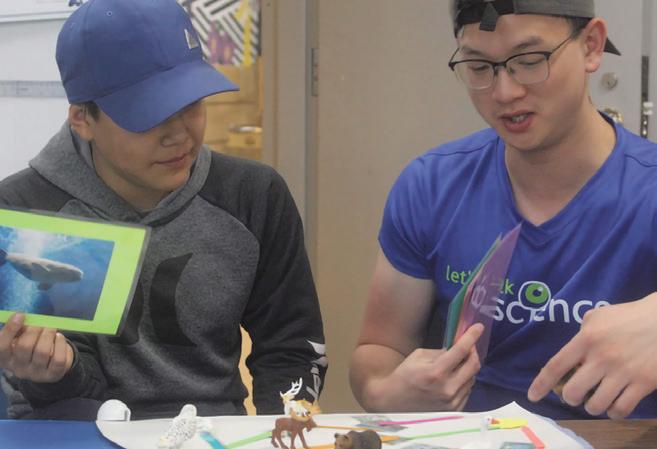
Let's Talk Science is committed to fostering a more inclusive and equitable STEM learning environment. One way we're achieving this is by integrating Indigenous Ways of Knowing (IWK) into our programs and resources. This commitment reflects our dedication to ensuring that all students have equal opportunities to explore and excel in STEM fields.
Tammy Webster, Director of Equity at Let's Talk Science, explains the importance of IWK in STEM education. "Indigenous knowledge is relational and quali-
deep engagement with one's community. This fosters a richer understanding and opens the door to diverse perspectives.”
Combining Western and Indigenous knowledge can be transformative. While Western science has made significant strides, Indigenous knowledge offers valuable insights and perspectives. By integrating both, we can open students to new ways of seeing the world and solving problems. As Webster states, "Climate change is a crisis demanding innovative thinkers,
Science programs address these issues by making STEM more culturally relevant. For example, outreach programs in remote Indigenous communities, led by volunteers from the University of Ottawa and Carleton University, have developed activities rooted in Indigenous culture, such as making snare traps and studying ice break-up.
Beyond outreach, Let's Talk Science integrates IWK into its broader programs. Elders and knowledge keepers advise on resource development and par -
communities and exploring the interconnectedness of all things.
Building strong relationships with Indigenous communities is essential for the sustainable integration of IWK. Shaw emphasizes the importance of long-term partnerships and open communication. "When people feel comfortable and invested, they are more willing to provide honest feedback and contribute meaningfully," she says.
Educators are enthusiastic about the new materials that integrate IWK. Shaw notes a
creating a more inclusive and equitable learning environment for all students. Join us in this journey towards a more just and innovative future.
To learn more about our programs and resources, visit letstalkscience.ca
ABOUT LET’S TALK SCIENCE
Let’s Talk Science, a leading partner in Canadian education, is a national charitable organization committed to inspiring and empowering children and youth of all ages in Canada to develop the skills they need to participate and thrive. To accomplish this, Let’s Talk Science offers a comprehensive suite of STEM-based programs to support youth, educators, and



Visit pama.peelregion.ca to learn more.



Explore exciting exhibitions plus create and connect during great programs and events for all ages!
PAMA celebrates community stories, experiences, histories, and cultures to promote conversation and understanding.
PAMA has been working in partnership with Living Hyphen and Sheridan College over the last two years to bring you an amazing new exhibition called Stories of Home: Finding Community and Belonging in Peel . This new exhibition takes you inside elements of a home and explores how we establish a connection to place, people, and community in creating a sense of belonging. Through personal stories, videos, images, and objects, the exhibit showcases connections between the Peel of the past, today, and the future.
“The moment the visitor enters the exhibition, they are immersed into a space that welcomes our differences,” said Amy Dunlop, Museum Curator. “It is our hope that this exhibit invites all to explore and celebrate Peel’s diverse histories and lived experiences as well as celebrating how we all come together to find a place of belonging in Peel Region.”
Unveiling Ability: Empowerment
Through Art , showcases an inspirational collection of quilts
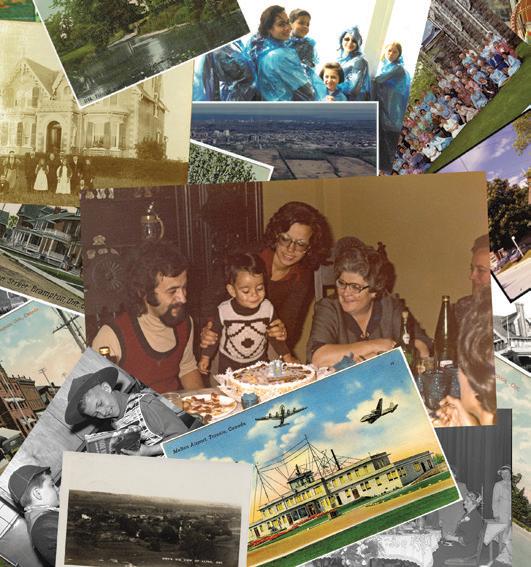
and paintings created by the artists of Brampton Caledon Community Living. Brampton Caledon Community Living empowers people living with disabilities to lead enriched and meaningful lives and to fully participate in their community. There are more exciting and diverse exhibitions to explore,
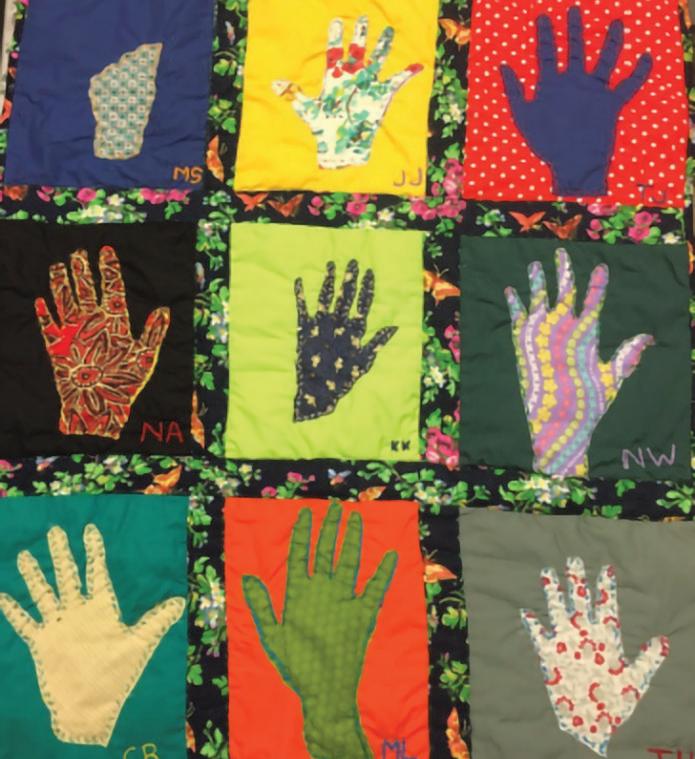
such as the new All Aboard! The Railways of Peel, Banquets and Belonging: Diasporic Celebrations in the GTA Kimutsik Oh My Dog! , and many more. Take the opportunity to explore four historic buildings, including a 157-year-old jail and courthouse!
PAMA has many exciting events and workshops year-round
for all ages. This October, join them for:
• Doors Open Brampton: Oct. 5
• Tea Leaf Reading Workshop with Cathy Skidmore: Oct. 10
• October PA Day at PAMA Bow Wow Bootcamp: Oct. 11
• Latin American Heritage Month with Hispanic Canadian Arts and Cultural
Association (HCACA): Oct. 19
• A Journey to the Middle East, Musical Ensemble Performance : Oct. 24 (registration required)
• Halloween at the Booseum Monster Pets at PAMA: Oct. 26
For information about admission and registration details visit pama.peelregion.ca
Accessibility is important to PAMA! They are a fully accessible facility and parking is free in all downtown Brampton municipal lots. Admission to PAMA is affordable at $20 for a family (two adults and up to five kids), $8 for adults, and $6 for seniors and students. If cost is a barrier, they offer free passes at any library in Brampton, Mississauga, and Caledon to sign out with your library card.
Visit pama.peelregion.ca or follow them on social @visitpama to find out more. Visit PAMA in person at 9 Wellington Street East in downtown Brampton.
ALLIE MURRAY
When Talina Papazian was six years old, her brother was diagnosed with an anaphylactic peanut allergy, which led him to face anxiety and social isolation. Seeing the challenges her brother faced, she felt a call to take action to make a difference for youth with disabilities, striving to understand the person beyond their diagnosis.
This journey brought her to Holland Bloorview Children’s Rehabilitation Hospital, where she began volunteering at their summer camp when she was 16. Now 18, Papazian is a long-term volunteer at the hospital, an advocate for disability inclusion, and a children’s book author.
Her book, You Taught Me, was released in August 2023 and follows a group of six children with visible and non-apparent disabilities. As the characters paint, garden, and blow bubbles, readers learn a series of skills, from being funny to finding happiness from within.
“While I had originally thought that I would teach the campers so many things as I was the volunteer, the kids taught me so much more
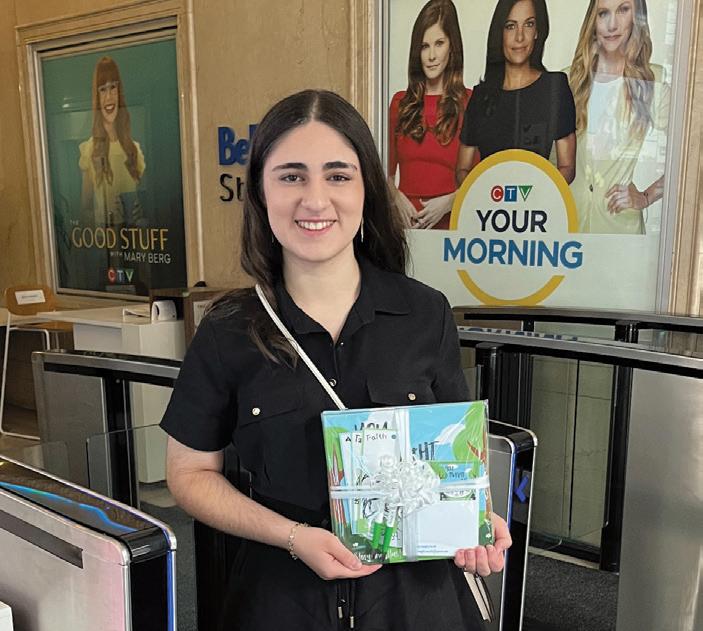
than I taught them,” Papazian explained. “That’s when the words ‘You Taught Me’ were floating in my head and I thought to myself ‘okay, let’s do this.’ My goal was to share my story with the world.”
As Papazian puts it, the release of her debut book was just the tip of the iceberg: it kickstarted an organization with the same name,
dedicated to sharing the importance of inclusion and accessibility.
“While the book itself was published in August 2023, I launched You Taught Me as a campaign in July of 2023, one month prior to publication,” she explained. “As I am hoping to share the importance of inclusion and accessibility with as many people
as possible, having a campaign allows me to connect with so many individuals and create a community that champions inclusion and accessibility.”
Through the You Taught Me campaign, Papazian has partnered with organizations across Canada like McMaster Children’s Hospital, Treat Accessibly, ErinoakKids and more. Similarly, she has been a guest speaker at several schools across Ontario, been featured in the media, and earlier this year, received the 2024 Rick Hansen Foundation Difference Maker of the Year Award.
“The profound significance of the award truly touched me when I had the incredible pleasure of meeting Rick Hansen in person at a different event shortly after receiving the award,” Papazian shared when asked about the award. “To be able to meet the person who founded the whole movement behind the award made the whole thing very real. I was very touched when he said ‘keep doing what you’re doing because you are truly making such a positive difference all across Canada.’”
Through both the book and the campaign, Papazian has three goals of how she would like to encourage others to give back: to help kids learn the importance of inclusion and accessibility and think about how to make the world around them more inclusive, encourage youth to believe in themselves, and that the funds raised from the book—which are all donated to support children with disabilities and their families—allow children with disabilities to access the support and tools they may need.
“I truly believe that everyone has such incredible ideas, knowledge, and opinions to share with the world, and through my work I hope everyone has the chance to do so by accessing support and believing in themselves,” she shared.
Looking towards the future, Papazian shared that she has many exciting things in store: the future release of You Taught Me in French, more guest appearances at Ontario schools to teach young readers about the importance of inclusion and accessibility, upcoming partnerships, and perhaps even a second book.
Meet David, who found a warm bed, meals, and reassurance within the doors of Scott Mission. Independence was everything to this senior. David owned his home and had a good-paying job. But that was before the pandemic struck, and his employer suddenly shuttered his business, leaving David unemployed.
He struggled to find work, as many seniors do.
“I had interviews over Zoom, but when they saw my grey beard, they judged me as too old, even though I had the experience they were looking for,” he recalled.
He went through his savings quickly and sold what possessions he could, but still lost his house to foreclosure—leaving him on the streets of Toronto with no one and nowhere to go.
“It was scary,” he remembered. “Not knowing what to do, where my next meal would come from, or just how to stay safe, or dry. It was very hard.”
Canada’s population is rapidly aging. Canadians aged 65 and older are part of the fastest-growing age group in the country today 1. More and more
people like David are coming to Scott Mission on fixed or zero incomes and are in absolute need.
“When I walked into Scott Mission, I was anxious and didn’t know what to expect,” said David, feeling lost and hopeless.
He was immediately supported by the Mission’s Welcome Centre
An emerging challenge for Scott Mission is caring for seniors with significant health challenges, some of them with palliative needs. Almost a quarter of Scott Mission’s men’s emergency shelter residents are over the age of 60. Nearly 40 per cent of those who access Scott Mission’s food banks are the most vulnerable—seniors and children.
team and was referred to the new Respite Centre, which opened last November in collaboration with the City of Toronto. The Respite Centre provides 50 emergency beds, showers, and meals for men at Scott Mission’s 502 Spadina Avenue location.
“I realized right away that these people were for real,” he said, now with noticeable relief on his weathered face.
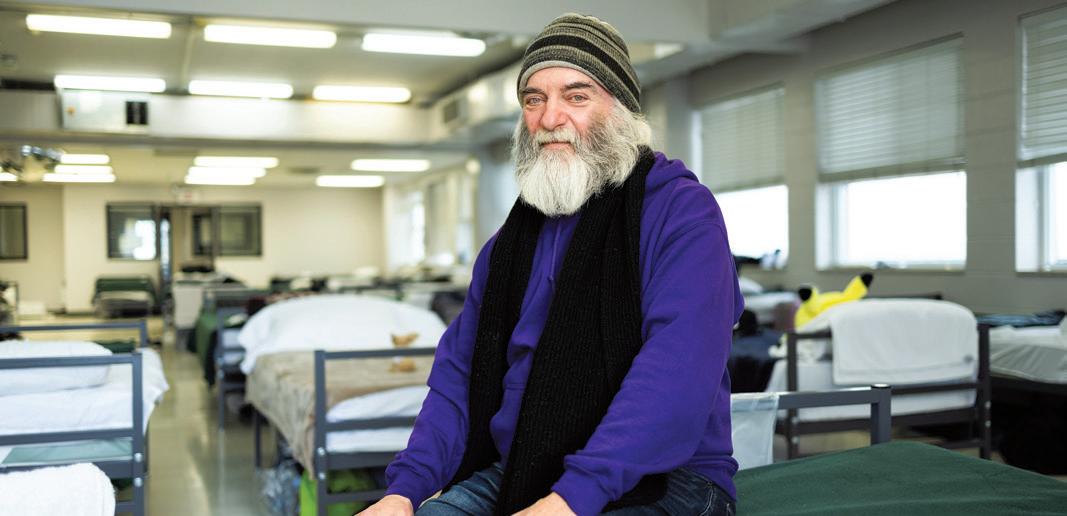
“Because of them, all my stress just flowed out.”
David is now on the path to recovering his former life of independence. Scott Mission’s team continues to stand by him, walking with him on his journey of transformation because LOVE IS THE WAY—the only way to give desperately needed help and encouragement to those who need it most. For 80+ years, the Mission has existed to “Serve one another humbly in love.”
“Thank God for Scott Mission,” said David, reflecting on his most difficult moments.

“Scott Mission treats people with respect, and I thank God that I found them.”
Scott Mission is a beacon of hope for men who experience hunger and homelessness across our city. Let LOVE lead the way this Thanksgiving! Donate at scottmission.com today!

When you serve on your condominium board, every decision you make matters, and juggling it all can seem complex. But the way to make it easier is simple—a partnership with a trusted and experienced property management company.
At FirstService Residential, our goal is to make your life as a board member easier. And we do that by bringing our service-first philosophy to life.
We are a proudly Canadian and North American-wide company. We are the largest property management company in Ontario, serving countless communities like yours throughout the province. But don’t let our size intimidate or deter you. Our service structure is designed to provide each of the communities we serve with the one-toone support they deserve. And there are numerous benefits to working with a company of our size and experience.
LEARNING FROM EACH OTHER
With so many associates across North America, we are constantly learning from each other.
We regularly interact with our counterparts in other states and provinces to learn what’s trending in their area. From the latest in amenities, to new technology, it’s easier to level-up in this ever-evolving industry when we have so many people keeping on top of the latest and greatest.
The learning doesn’t stop with trends. Best practices for handling specific property management tasks are shared throughout the company and moulded to suit each market. The lessons we learn trickle down to our communities and the boards that serve them.
ROBUST SUPPORT FOR YOUR PROPERTY MANAGER
Each of our property managers is supported by a regional director, vice presidents, president, and administrative team that all work out of one of our two offices located in the GTA. These professionals provide strategic guidance and handle the administrative needs of our property managers.
Additionally, as a North American-wide company, your local team has the backing of
countless associates and communities from across Canada and the United States, bringing even more knowledge to the table. Meaning, if your condominium is faced with a challenge that your property manager or local team does not have experience with, they can quickly find insights from experts and thought leaders throughout our organization who hold decades of experience.
Another benefit to partnering with a management company of our size is gaining exclusive access to our affiliate companies like FirstService Energy. Our trusted energy advisor, FirstService Energy, offers customized and cost-effective solutions to boost efficiency and reduce energy consumption costs, reducing a community’s carbon footprint. These days, the cost of maintaining a large condominium community only seems to increase. So, access to a company like FirstService Energy, which will work closely
with your board to find sustainable energy solutions and identify local incentive programs that can save your condominium money, will benefit your community for years to come.
A big part of board business is vendor management, as it takes several third-party service providers for a community to run smoothly. Whether it’s an elevator that needs to be repaired, snow removal, or landscaping, your board needs to find dependable vendors they can trust to get the job done in a timely manner and on budget. Our size permits us to do the vetting of potential vendors for our board members and allows us to provide a comprehensive list of preferred local vendors that can service your community.
“There is a common misconception that when you work with a large company you lose that personal touch you gain from smaller companies,
and we are the perfect example of that being untrue,” said Mark D. Hopkins, President of FirstService Residential Ontario. “The professionals that service our communities throughout the GTA are local. They understand the ins and outs of your neighbourhood because many of them live there too. But the fact that we can reach out to our counterparts across Canada and the U.S. makes us that much stronger. We can offer our communities proven and practical solutions to the challenges of community living because we have truly seen it all.”
At the end of the day, we don’t do what we do because we love budgets or bylaws, or because we just can’t get enough of reports and regulations. We do it for our communities. Because we aren’t just in the business of residences. We’re in the business of community building and making people feel at home.
And with the season of giving thanks upon us, we want to thank those communities that continue to put their trust in us. Because together we make life, simplified.





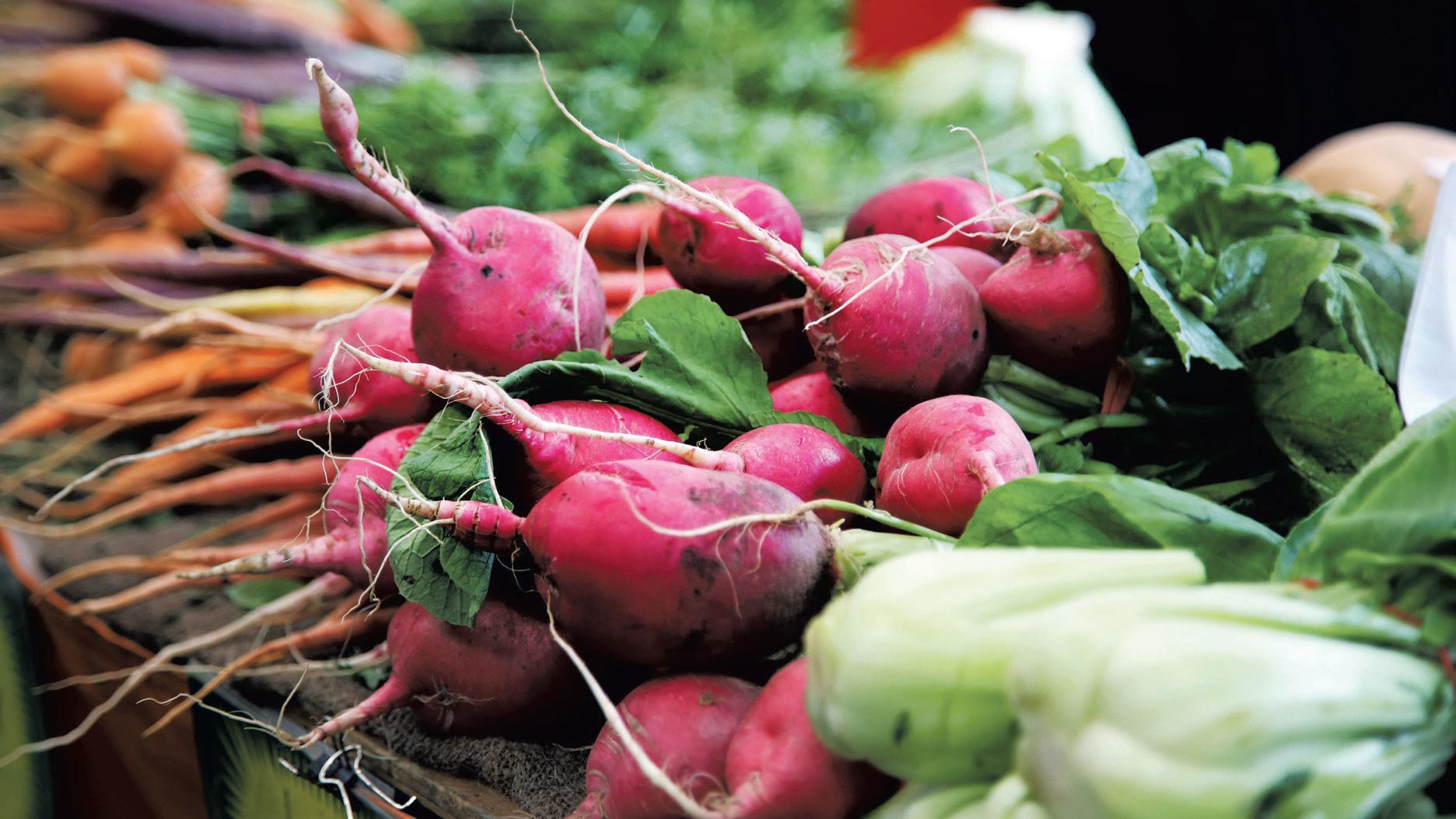
is suitable for food production, this is an issue that cannot be ignored.
When it comes to farmlands and our collective future, it's crucial to recognize the long-term impact this trend will have on our society, economy, and environment.
THE FUTURE OF FOOD
Ontarians care where our food comes from, but protecting farmland is not just about safeguarding our food supply; it is also about ensuring food safety, food sovereignty, and price stability. It is about mitigating and adapting to climate change, supporting rural economies, and preserving the knowledge and traditions that have sustained us while embracing technological advancements in agriculture.
However, this will only be possible if we ensure the long-term land security needed for diverse food production. As it stands,

the current rate of farmland loss in Ontario is unsustainable. In the last 35 years, Ontario has lost 15 per cent of its farmland. At the current pace, that number will climb to 35 per cent over the next 35 years. If this trend continues, future generations may find themselves without enough land to grow their own food.
Farmland is the foundation of Ontario’s agri-food industry, contributing $47 billion to the economy, with $9.3 billion coming directly from the production of agricultural commodities. Yet, there
Preserving
is a troubling disconnect between the rising costs of farmland, the struggles of farmers, and the profits of food processors and retailers. From 2020 to 2023, farmland prices in the southwest of Ontario have soared, with the average price per acre jumping from $19,100 to $32,700. This is why organizations like the Ontario Farmland Trust (OFT) are so vital.
For over 20 years, OFT has been a critical voice in farmland protection, partnering with
ers, and conservationists together to address Ontario’s farmland’s pressing issues. Currently, there is no centralized resource centre to support efforts for farmland preservation. The good news is that OFT is well-positioned to create one. This would provide essential resources to community members, planners, municipal councillors, and others, empowering them to engage in meaningful advocacy for local farmland protection. By fostering a deeper understanding of agricultural systems and land use planning, we can address the affordability and accessibility of farmland.
Agriculture in Ontario also needs new pathways that make farming a realistic career option, especially for those not from farming backgrounds. With 40 per cent of farmers set to retire in the next decade and 66 per
riers that are discouraging young people from entering agriculture. The solutions to these challenges lie in creative planning and strong policies that ensure development supports agriculture rather than undermines it. OFT’s work with farmland easements, which have permanently protected 26 properties and over 2,600 acres across the province, is a key tool in this effort, ensuring that our limited farmland remains protected for food production. As voters, we must prioritize farmland preservation in every election. Our elected officials will listen if we clarify that this issue matters to us. The decisions we make now will shape the legacy we leave for future generations. Preserving farmland is not just about protecting land; it is about ensuring the resilience and prosperity of our communities for years to come.
ALLIE MURRAY
Deep in the COVID-19 lockdown, while trying to find a way to pivot her Indigenous tourism experiences in Ottawa, Ont., Trina Mather-Simard discovered her Trojan horse: the Ojibwe Spirit Horse, quietly carrying a powerful new direction.
As the pandemic forced her Indigenous tourism business— Indigenous Experiences—to temporarily shut, she began to realize that the tourism industry would be forever changed. After 19 years of successful operations, Mather-Simard and her team strategized how to move forward in a changed world.
“During this process, while I was at home with my family during one of the COVID lockdowns, I heard an interesting story of the Ojibwe Spirit Horse by an artist and knowledge keeper, Rhonda Snow,” MatherSimard explained. “I was instantly connected to them and inspired by their shared story of
losing their connection to their traditional lands, but a positive story of resilience—they are still here! Just as our communities are still here! I knew they needed to join our team as four-legged ambassadors and be part of our story we shared.”
The Ojibwe Spirit Horses are the only horse breed native to Canada—they stand out against the rest because of their smaller stature and hairy ears equipped for the Canadian winters. The breed almost went extinct in the 1970s after they became victim to hunters who viewed the horses as a nuisance for eating their crops and ruining their fields. Then, some members of the Lac La Croix First Nation captured the four remaining wild mares, took them to Minnesota, and started to bring the breed back to life. Their efforts proved successful, with more than 180 Ojibwe Spirit Horses registered today. When Mather-Simard heard the tale from Snow, she felt an immediate connection to the breed.

When lockdowns were lifted in Ontario, she and her daughters made the trip from Ottawa to Chatham, Ont. to visit a farm that housed some of the ponies—and it was love at first sight. “As soon as I met the ponies, I knew that the Ojibwe Spirit Horses were different from any other horse I had encountered,” she explained. “I also knew that if I wasn’t aware of their existence and their connection to our community, then most of our community—and in fact, all Canadians—were not aware and it was an important story to share.”
When it was safe to reopen, Mather-Simard rebranded the former Indigenous Experiences to Mādahòkì Farm, which means “to share the land” in Anishinaabe.
With a new name and new experiences to share, Mādahòkì Farm also brought new land. MatherSimard approached the National Capital Commission, noting that they were searching for new land. They were presented with 164 acres of land in the greenbelt to expand the farm.
In addition to sharing the story of the horses, Mādahòkì Farm offers an Indigenous marketplace
and Indigenous experiences, including their annual Summer Solstice Indigenous Festival.
“Mādahòkì Farm welcomes visitors to share the land with us and experience all of the rich Indigenous culture and traditions that are connected to these traditional lands of the Anishinaabe,” Mather-Simard noted. “We are open year round for visitors and to engage all of our visitors on this path to understanding and reconciliation through experiences of art, dance, food, stories and of course, ponies.”
Looking forward to 2025, Mādahòkì Farm plans to expand their programming to offer immersive guided walks with the ponies, a crafting workshop, and cooking bannock over the fire. They are also fundraising for two new large investments—Canada’s first large-scale biodiverse on-water Indigenous cultural attraction and a project to expand their existing pavilion on the farm, allowing them to host larger events, community gatherings, and more.
Home sweet home—many of us will spend about 62 per cent of our lives at home. As we age, the comfort and safety of home only become more important. That’s why, for 60 years, Ivan Franko Homes has created a "hive," helping Ontario’s senior community capture the feeling of comfort and community.
A LEGACY OF LOVE AND CARE SINCE 1964
In its early days, starting in Toronto and then in Mississauga, Ivan Franko Homes welcomed younger seniors. These residents brought a vibrant array of hobbies, such as gardening, pottery making, and beekeeping—a welcome connection to the organization's logo.
Throughout the changes over the last six decades, community and engagement in activities remain central to life at Ivan Franko Homes. In addition to serving the Ukrainian-Canadian community, Ivan Franko Homes champions inclusivity by welcoming all groups.
VISION FOR THE FUTURE:
A CAMPUS OF CARE
Ivan Franko Homes has grown significantly since its humble beginnings, now taking on an ambitious $88 million project at its Mississauga site. With a proud history of serving over 7,600 seniors in 60 years, Ivan Franko Homes remains deeply committed to honouring its roots while embracing a bright future.
“Love lives at Ivan Franko Homes,” said Olya Vovnysh, CEO of Ivan Franko Homes. “We honour the past to build the future.”
As the population of seniors continues to grow, including many with dementia, Ivan Franko Homes recognizes the increasing demand for senior care. Looking ahead, Ivan Franko Homes envisions creating a comprehensive Campus of Care that caters to all generations. This state-of-the-art facility will enhance residents' daily lives, providing a modern, compassionate environment that upholds the spiritual, cultural, religious, and
"Ivan Franko residence is truly a remarkable place one can call home for your senior years," said Jean Ann Lyseyko. "The care, friends, and varied activities are a blessing to senior living and enjoyment."
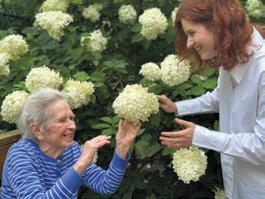
dietary traditions that keep them connected to their heritage.
This vision includes features that allow couples to live on the same site, whether independently, in assisted living, or long-term care. Keeping loved ones close in old age significantly benefits quality of life, and this model ensures that residents receive the care they need without the heartache of separation.
“We are thrilled that our mother resides at the Ivan Franko Retirement Residence,” shared Lila Scott, a long-time supporter and volunteer. “The staff’s dedication and personalized care ensure that each resident’s unique needs are met with compassion and understanding. As our mother approaches her centenary with a mind as sharp as ever, we appreciate knowing that the new Centre for Aging and Longevity will offer exceptional care if her needs change.”
The staff at Ivan Franko Homes takes care of the seniors like their own parents, mirroring the dedication and warmth symbolized by their beekeeping-inspired logo. Just as bees work together
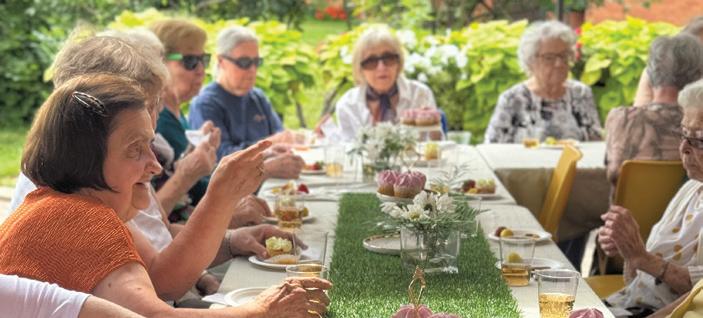
harmoniously to nurture and protect their hive, their team provides wholehearted care and support to each of their residents. This deep commitment to the well-being of residents creates a nurturing environment where both staff and residents thrive. You can see the mutual appreciation in the gestures of gratitude, hand-holding, and meaningful eye contact—human connection is always top of mind.
"I am constantly impressed by the level of care and attention that my mother receives daily from the dedicated PSWs, the nurses, doctors, and staff,” said Irene Poliszchuk. “The PSWs look after my Mom as though she was their family member and ensure that her best interests are looked

after. Ivan Franko feels as close to 'Home' as possible."
HOW YOU CAN SUPPORT Now is the time to "Bee the Change." Your support—whether through a monetary donation or volunteering your time—can bring joy and make a lasting impact on the lives of our beloved seniors. Every contribution and donation helps Ivan Franko Homes grow and continue serving our community. Together, we can build a brighter future for those who once cared for us. For more information on how to get involved or to donate, visit ivanfrankohomes.com

Imagine a time when a loved one needed a new treatment that could make all the difference—a parent battling a chronic illness, a child with a rare condition, or a friend fighting cancer. In those moments, hope often hinges on the availability of the latest medical innovations. However, in Canada, accessing these breakthrough treatments can be frustratingly slow. Despite our advanced healthcare system, delays in making new medications available are an additional burden during an already difficult time. These life-saving treatments must reach those who need them quickly and efficiently because no one should have to wait for hope. We must ensure new discoveries are within reach of Canadians.
Despite Canada’s status as a developed nation and pioneer of universal healthcare, red tape around regulatory processes is preventing patients and healthcare professionals from accessing the latest healthcare innovations in a timely manner. Right now, less than 20 per cent of new medicines launched globally are available on Canadian public plans. It also
takes, on average, more than two years following Health Canada approval for a given drug to be available to Canadians through public drug plans—that’s almost double the average time of access amongst Canada’s 20 OECD peer countries and places us last in the G7. As the federal government seeks to implement its approach to national pharmacare, provincial governments will consider the needs of patients in their health systems as a first priority. This is an opportunity to reduce red tape rather than adding more to an already complex system.
Let’s start with the obvious: new drugs and treatments can be a patient’s last chance at life. A recent study in the Lancet tells us that new, targeted therapies can reduce mortality rates by up to 30 per cent for those with rare diseases and advanced-stage cancers. In other words, access to a new treatment could be a patient’s last hope if they have had little luck with conventional and current options. On the
other hand, according to PHAC, chronic diseases and other illnesses cost the Canadian economy $190 billion annually, including $122 billion in indirect income and productivity losses and $68 billion in direct health
care costs. New treatments could radically decrease the number of hospitalizations that cause delays in our already stretched healthcare system and help Canadians get better and back to work sooner.
The economic contributions are significant, too. The latest statistics tell us that the innovative pharmacare industry is responsible for up to $3 billion in research and development, 103,000 high-quality full-time jobs, and $16 billion in yearly economic impact in Canada alone. We want to ensure Canadian innovation stays in Canada, too. Further supporting and adopting innovative technologies and treatments will improve healthcare outcomes for Canadian patients and encourage greater industry investment. To do this, we must collectively shift our focus toward collaboration and risk sharing. After all, this is a global
competition where industry investments go to countries where the business environment is consistent and predictable.
The pandemic has proven how the critical needs of a society can accelerate approval mechanisms. During the COVID-19 pandemic, we have seen how a health crisis can reduce red tape overnight. Furthermore, understanding the significance of these advancements helps us appreciate why timely access to new treatments is so important. By supporting accelerated access to innovations, we are investing in the health and future of every Canadian while also investing in economic growth and jobs. Ensuring that new, effective treatments are available quickly can not only be a matter of life and death but also can reduce the burden of those with acute and chronic diseases, making our commitment to advancing medical science a shared priority for all.
To become a global leader in innovative healthcare, Canada needs to implement policies that encourage a predictable and consistent business environment
that will encourage private investment and foster innovation to support the development of new treatments. Premier Doug Ford has been a vocal advocate of improved access by reducing approval times for new medications, emphasizing the need for a streamlined process to benefit patients with the latest advancements in medical science. He has set the table for change and action. Now, it is the responsibility of systems leaders to act! There is urgency to make impactful changes; the time to act is now. Canada must prioritize timely and equitable access to innovative treatments, ensuring that our healthcare system meets the needs of Canadians without delay. We can strengthen our healthcare systems, drive economic growth, and maintain our standing as a leader in discovery research. By embracing policies that support accelerated access to new medicines, we can provide hope to those who need it most and ensure that life-saving treatments are within reach—especially when it is someone’s only lifeline. The path forward is clear—let’s work together to make it a reality.

New drugs and treatments can be a patient’s last hope. Right now, fewer than 20% of new global treatments are available through public drug plans in Canada. Together, we can cut the red tape, save lives, and provide hope when it matters most.

Since the first hydropower facility was commissioned in 1891 in our nation’s capital, waterpower has flowed throughout Canada’s history, becoming an integral part of our country’s fabric. Some hydropower facilities in Canada have been in operation for more than 100 years, and with
proper upkeep and refurbishment, they can last another 100 years or more. Canada is now home to more than 500 waterpower facilities nationwide, and waterpower is its most abundant source of clean and renewable energy. Waterpower supplies electricity

for six out of 10 Canadian homes and businesses, and approximately 16 million Canadians live in provinces where 90 per cent or more of electricity is derived from water power. Additionally, communities serviced and supported by water power can attract industries in adjacent sectors due to water power's unique operational and environmental attributes.
Waterpower is truly Canada’s big blue battery.
WATERPOWER IS HERE FOR THE LONG-HAUL
Canada is committed to ambitious Greenhouse Gas (GHG) reduction targets as part of a global effort to combat climate change. These include economy-wide reductions of 40 per cent from 2005 levels by 2030 and a net-zero electricity sector by 2035. As these target deadlines rapidly approach, Canada will need to reduce fossil fuel consumption while increasing the production of electricity from renewable and non-emitting resources. This process is called “clean electrification.”
Since Canada’s earliest days,
waterpower has harnessed the strength of Canada’s rivers to meet our energy needs. Waterpower is again ready to answer the call as environmental needs become increasingly intertwined with our need for reliable energy.
Waterpower is unique in that it is the only renewable form of baseload electricity (the minimum amount of power needed to supply the electric grid at any given time), with long-term energy storage from reservoirs and pumped storage. Producing no air pollutants and with ultra-low GHGs, water power is reliable and can be produced on demand, unlike variable renewables that are weather-dependent.
As an organization, WaterPower Canada is committed to furthering the momentum of important energy conversations. We recently held Canadian Waterpower Week (CWW), our annual national conference and trade show, in Ottawa from September 25 to 27.
Under the theme of “Forward Together,” CWW brought together key decision-makers, industry experts, Indigenous
leaders, and policy and business influencers, fostering collaboration and innovation in the pursuit of sustainable energy solutions. Exchanging knowledge and networking, industry leaders, policymakers, and stakeholders explored the future of waterpower and how our industry is taking action to combat climate change. We look forward to reconvening next year and continuing the momentum from this year’s conference. To learn more about Canadian Waterpower Week, visit waterpowerweek.ca!
Canada has the potential to more than double its current capacity to meet energy demand while supporting our clean energy objectives. We believe hydropower should form the backbone of future development. Our industry is eager to collaborate with governments, Indigenous groups, and communities across Canada to move the needle towards net zero. Canada is and will be powered by water. WATER WORKS.
Waterpower is here to lead the charge to net zero. Learn more at WaterPowerCanada.ca
HANNA RANTALA
Former professional rugby player Ed Jackson, who defied medical opinion by learning to walk again after a near-fatal spinal cord injury, says victims of trauma should resist the impulse to suffer in silence. Jackson broke his neck when he mistakenly dived into the shallow end of a swimming pool in 2017. He was paralyzed from the shoulders down and told he would never walk again.
He shares his journey to recovery in the 2023 documentary film "The Mountain Within Me," which shows him challenging his prognosis.
Home videos capture the moment his toes start moving and track the arduous rehabilitation work that leads to him walking for the first time six months later. It sees Jackson climbing
Snowdon, the tallest mountain in Wales, as he marks the first anniversary of his accident and setting his sights on higher peaks as his physical condition improves and his ambitions grow.
"Being told you're not going to walk again and then climbing a mountain is quite symbolic, so I wanted to do that to try and send some hope," Jackson, now 35, said. "And then I got hooked on it. So, let's see how high we can go. It's led me to some pretty ridiculous places which you'll see in the film."
Directed by Polly Steele, the documentary focuses on Jackson's 2022 trip to Nepal, an attempt to summit the 7,000-metre Himlung Himal and another vertigo-inducing climb in the French Alps. His recovery journey is told through archive footage, mobile phone videos, social media posts and interviews
with his family.
Looking back and hearing the testimonies of his loved ones was not easy, Jackson said.
"I think connecting with it in such an intense way during the film and really going in deep did bring some emotions to the surface," he said.
"I wanted to be as raw and honest as possible because that's really the only way to help people," said Jackson, who, with his wife Lois, founded the Millimetres 2 Mountains charity to help others struggling with trauma.
Asked if he had any advice, Jackson said: "The first thing people do when they've been through trauma is isolate themselves. So, just be open and honest about your struggles, don't suffer in silence."
And for anybody else, "You're lucky to be alive in the first place, so get out there, say 'yes' to stuff and go on adventures."
—Reuters

Navigating life after an acquired brain injury is challenging, to say the very least. It’s a lifelong journey that requires not just care but a comprehensive, individualized
record of enhancing organizations by improving financial revenues, expanding services, and managing growth. His passion for client-focused care and collaboration has
its service delivery models. When home visits became impractical, VCBIS quickly transitioned to virtual services, ensuring continued client support.
education, expert speakers, and policy discussions. This event fosters a greater understanding of ABI and strengthens the community of support surrounding those affected.

sources of funding either from government sources or the private sector, as a brain injury can occur to anyone, and the effects on the ily, and friends are life-altering,”
mitted to advancing research in ABI care and collaborating with local universities to improve client ture innovations. As they look to the future, their commitment to nity-driven care ensures a brighter


With back-to-school season in full swing, ensuring your children are prepared to take on their studies is essential—and doing so ahead of their first report card can make all the difference. One especially crucial but often forgotten need is an eye health check-up. And if your child reports trouble seeing the board during class, it’s high time for an exam.

Myopia, commonly known as nearsightedness, is becoming a global epidemic, especially among children. By 2050, it is projected that half of the world's population will be affected by myopia, 1 with a significant percentage developing high myopia—a condition that poses severe risks of sight-threatening eye diseases later in life. The prevention of high myopia is critical, and early intervention can change the course of the disease and your child’s life. Proper eyeglasses are the first step: when it comes to your child's eyesight, every diopter counts.
WHAT IS MYOPIA?
Myopia occurs when the eye grows too long from front to back, causing distant objects to appear blurry. It is the most common refractive error among children and young adults, often developing at a young age and progressing rapidly. Unfortunately, myopia is frequently misunderstood as merely a need for prescription glasses, overlooking the potential long-term damage to sight and quality of
life if not properly managed as a medical condition.
Recognizing the gravity of this issue, the World Council of Optometry and the Canadian Association of Optometrists have established myopia management as a standard of care. This approach emphasizes correcting vision and controlling myopia's progression to prevent future complications. For Canadian eye care professionals, myopia management presents a unique opportunity to build value and trust by educating parents about its importance.
ESSILOR'S STELLEST LENSES: A GAMECHANGING INNOVATION
The key to success in combating myopia lies in raising awareness about the risks and consequences of untreated myopia. This is where Essilor Stellest lenses come into play. Stellest lenses are a revolutionary treatment proven to slow myopia progression by an average of 67 per cent when worn 12 hours a day, compared to single-vision lenses. 2 With Stellest Sun lenses,
now available in sun tints with six fun colours for kids, not even summer fun can get in the way of your child's eye health. Essilor Stellest lenses offer a dual benefit: they correct vision and actively control the progression of myopia. This makes them an essential tool in the fight against the myopia epidemic, providing a solution that goes beyond traditional lenses to protect children's eyesight in the long term.
TAKING ACTION
With the first school report cards on the horizon, clear vision is critical for your child’s success in school and beyond. If your children show any signs of myopia, such as squinting, sitting too close to screens, or complaining of headaches, don’t delay booking an eye exam. This simple three-step process is an easy way to ensure your children are protected against myopia:
VISIT YOUR EYECARE
PROFESSIONAL
Schedule an eye exam with an optometrist to assess your child's
vision and discuss the possibility of myopia management.
ASK ABOUT STELLEST LENSES
To correct and control myopia, order Stellest lenses from an eye care professional based on the optometrist's prescription.
SCHEDULE FOLLOW-UP VISITS
Regular six-month check-ups are recommended to monitor myopia progression and adjust the treatment as necessary.
Parents, choose Essilor Stellest lenses and take proactive steps to slow the progression of myopia and protect your children's vision. Book an eye exam today and ask for Stellest lenses by name to ensure your child's vision is in the best hands.
Learn more about Essilor Stellest lenses at essilor.com/ca-en/ products/stellest
The Venetian Lagoon, a UNESCO World Heritage Site, is a critical ecological treasure. Its unique salt marshes, known as "Barene," maintain the delicate balance necessary for this precious ecosystem.
Intertidal wetlands like Barene are vital for the region's biodiversity and its ability to combat climate change by sequestering carbon. However, these precious ecosystems need protection—the wetland environment, including the fauna and flora it houses and the culture and traditions surrounding the lagoons, are under threat due to human impact and natural erosion.
To protect these vital areas, The TreadRight Foundation, the not-for-profit arm of The Travel Corporation (TTC) and Insight Vacations, has partnered with Venice’s Barena Association to support their flagship project, SOS Barena.
“As one of Italy’s largest coastal wetlands, the Venice Lagoon is not just of deep significance environmentally but also culturally. Our newest nature-based solution
partner, Barena Association, acknowledges this beautifully by harnessing the knowledge and skill set of the local fishermen, who design and install interventions to stall rapid erosion and maintain the lagoon’s power to trap carbon,” said Shannon Guihan, Chief Sustainability Officer at The Travel Corporation and Head of TreadRight. Thanks to TreadRight’s grant, the SOS Barena project will construct up to 150 metres of biodegradable fascines. These barriers, installed with the expertise of local fishermen who have an intimate connection with the lagoon, will then have sediment pumped between them and the marsh’s edge, helping root systems to develop and preventing further erosion.
TreadRight has supported more than 60 projects worldwide since 2008. In alignment with The Travel Corporation’s net-zero ambition and Climate Action Plan, the foundation now prioritizes support for nature-based solutions to the climate crisis, which helps local
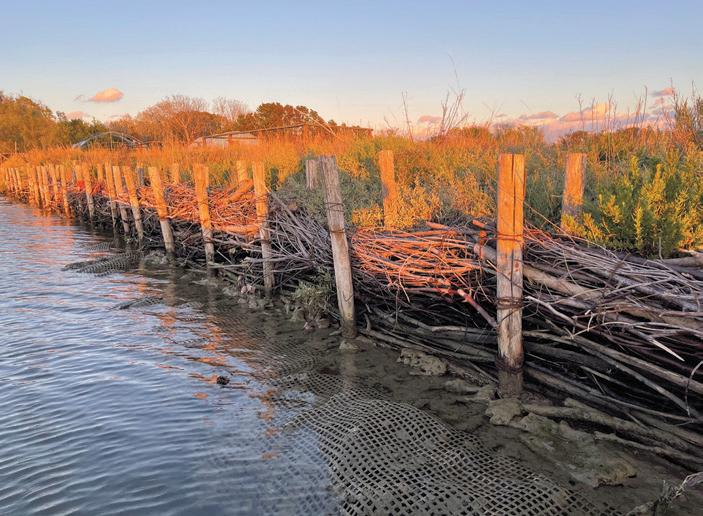
communities become more resilient to climate change.
“The Barene is critical to the unique ecosystem that encompasses Venice, and we are exceptionally pleased to champion this initiative through our TreadRight grant,” Guihan added.
COMMUNITY-
APPROACH
The SOS Barena project is unique not only for its environmental


impact but also for its strong community involvement. The Barena Association’s approach integrates the skills and knowledge of local fishermen, particularly those from the island of Burano, who play a crucial role in designing and implementing conservation efforts. Their participation ensures that the solutions are effective and sustainable, preserving both the environment and the traditional fishing culture that has thrived in
the lagoon for centuries.
“Salt marshes effectively absorb carbon emissions, which makes them crucial in addressing climate change, but they also enable the traditional fishing culture to thrive—and that is paramount to ecological sustainability,” said Allison Zurfluh, President of Barena Association. “In the northern Venice Lagoon, we are committed to nature-based solutions installed by traditional Buranello fishermen not only to protect and restore these valuable saltmarshes, but because the methods we use directly support their lifestyle as custodians of the lagoon. We believe in what we are doing and are passionate about it. Our gratitude to the TreadRight Foundation runs deep.”
Thanks to the carbon sequestration capabilities of the restored habitats, the restoration efforts are expected to prevent CO2 emissions ranging from 17.7 to 59.3 tonnes. This partnership is a perfect example of how environmental conservation can go hand in hand with cultural preservation and community empowerment.

Something special is coming to the recreational waterway in Welland, Ontario. Lock & Quay is Welland’s largest waterfront community, a new development project poised to redefine Welland as we know it.
This is big news in more ways than one. Lock & Quay will have as many as 4,500 residences, 45,000 square feet of commercial space, and several hectares of park and waterfront green space, making it the largest development in Welland’s history. And with so many exciting opportunities to explore, it’s a chance to build your family’s legacy in a comfortable, stylish, and tranquil region.
EXPLORE LOCK & QUAY
Lock & Quay is thoughtfully designed, with four distinct neighbourhoods, each with its own unique features and character. At the heart of the development,
Quayside Village features a pedestrian-friendly promenade lined with shops, boutiques, markets, street performances, dining, and cafes. This village is designed to be a social hub where residents enjoy community events, cultural experiences, and a lively atmosphere.
The North and South Quays, on either side of Quayside Village, are the primary residential neighbourhoods of Lock & Quay. They offer a variety of beautifully crafted urban townhomes located in cozy modern enclaves connected to Quayside Village and the waterfront by walkways. Integrating green spaces and walkways encourages a healthy, active lifestyle, making it easy for residents to explore their surroundings.
At the far south end of the development is Bridgeview Locks, a gateway neighbourhood with mid-rise condominiums and a public park. This neighbourhood
is just a short walk to the local Seaway Mall, where residents will find shopping, dining, and entertainment options.
This amenity-rich community will be located along Welland's recreational waterway, a 12-kilometre stretch where residents can swim, fish, and enjoy canoes, kayaks, and other non-motorized watercraft.
The waterfront esplanade that runs the length of the community along the canal is perfect for biking, walking, or lounging by the water. A central feature of Lock & Quay, the esplanade offers stunning water views and creates a sense of continuity throughout the development. Linked to the area’s trail system, the esplanade includes a pedestrian bridge to Merritt Island for even more outdoor recreation and exploration opportunities.
Lock & Quay also features a number of sustainability initiatives to reduce the impact on the natural environment and promote more efficient energy and water use. Pedestrian-friendly streets, building material selection, landscaping, and urban design have all been carefully managed to mitigate the community’s environmental impact, strengthen the local environment, and help residents save on utility costs, making Lock & Quay a smart choice for eco-conscious homebuyers.
Beyond the environmental considerations, Lock & Quay aims to foster a strong sense of community among its residents. The design of the neighbourhoods encourages interaction with communal spaces, parks, and public areas where people can meet and
socialize. Lock and Quay will soon be a healthy and connected community where people of all ages can gather and enjoy their surroundings—and you can be a part of it!
Visit LIVHere.ca to stay up to date on the latest releases at Lock & Quay and be the first to know about exclusive offers and events.
LIV Communities is a family-owned business based in Burlington, Ontario. For over 45 years, LIV has developed a reputation for designing and building exclusive, high-quality homes in desirable locations. Through its pillars of loyalty, integrity, and vision, LIV is committed to carrying on this proud tradition for families in this beautiful community in Welland.



Nestled at the southern tip of Georgian Bay, Collingwood is a dynamic waterfront community that beckons visitors with its unique blend of small-town charm and big-city amenities. It features an unparalleled culinary and craft beverage scene against the backdrop of a historic downtown.
This picturesque town is not just a destination; it's an experience that captivates young explorers, families, and seasoned travellers alike.
One of Collingwood’s greatest appeals is its ability to offer the best of both worlds. Visitors and residents enjoy the convenience of urban amenities—such as top-notch dining, shopping, and arts—without sacrificing the tranquillity and charm of a small-town environment. This harmonious blend of urban and rural elements makes Collingwood an extraordinary place to explore.
Collingwood’s food scene offers a diverse range of eateries, from North America’s first Caesar bar to farmto-table restaurants and markets. Talented local chefs champion local suppliers, providing unforgettable artisanal culinary experiences. Take a stroll down Collingwood’s historic main street, which is full of shops, restaurants, cafes, boutique hotels, and art galleries. Discover hidden gems, upscale waterfront dining, and more at www.livemorenow.ca/ collingwoods-restaurants
TOUR, TAP AND TASTE THE BEST OF OUR BEVVIES!
Beyond offering unparalleled recreational opportunities year-round, Collingwood is also quickly becoming known as Ontario’s Craft


Beverage Capital. The town’s history of brewing and distilling goes back to the 1800s, so when you are looking to experience this historic tradition fully, take a few days on a self-guided tour of the award-winning craft beverage distillers and producers in Collingwood. Check out www.craftbeveragecapital.ca to experience our diverse bevvie excellence accompanied by patios, live music, food and expertly crafted souvenir swag.
The town’s vibrant arts and culture scene is a cornerstone of its identity. With a calendar packed with music festivals, art shows, and cultural events, there is always something happening in Collingwood. The local arts community thrives here, with galleries, theatres, and creative
spaces that showcase the talents of local artists and performers. This rich cultural fabric is a testament to the town’s commitment to nurturing creativity and expression. Since its founding in 1858 as a railway and shipping terminus on Georgian Bay, Collingwood has been known for its fascinating history and heritage architecture. Officially recognized by Canada’s Registrar of Historic Places, its downtown core is home to some of the best-preserved 19th-century main streets in Ontario.
Collingwood is a year-round haven for outdoor enthusiasts. Discover iconic fall colours along the beautiful waterfront, or discover Collingwood as a snowy wonderland with worldclass ski resorts that attract skiers and snowboarders from all over. As the
snow melts, Collingwood’s landscape blossoms into lush greenery, perfect for hiking, biking, and exploring the scenic trails that weave through the area. The stunning Georgian Bay offers endless boating, fishing, and watersports opportunities, making it a year-round paradise.
In Collingwood, the outdoors is always within reach. Just 15 minutes from Blue Mountain Resort and 20 minutes from Wasaga Beach, the world's longest freshwater beach, Collingwood offers over 60 kilometres of recreational trails for cycling, walking, jogging, cross-country skiing, and snowshoeing. These trails connect every major attraction!
WE HAVE IT ALL!
Collingwood has something for everyone, whether you’re seeking adventure, nature, culture, or relaxation. Discover this harbourfront gem's magic—your gateway to an unforgettable Ontario experience. The phrase ‘come for a weekend and stay for a lifetime’ was inspired by Collingwood! Download the Discover Collingwood app today to plan for your visit!
www.DiscoverCollingwood.ca
The Colombian Amazon is full of wonders for adventurous travellers to discover. But promoting sustainable tourism in a region historically marked by conflict and insecurity is no easy feat.
For over a decade, Biodiverso Travel, an interdisciplinary group of professional tourist guides, has worked tirelessly to showcase the natural beauty, culture, and history of their homeland. Their mission is to provide memorable travel experiences and foster environmental conservation and social transformation.
CONSERVATION AND EDUCATION
Biodiverso came from a deep love for the Amazon’s fragile ecosystems, threatened by deforestation and habitat loss. By partnering with local rural families and businesses, Biodiverso has created a tourism model that educates visitors while promoting environmental stewardship.
"We live surrounded by lush nature, but it’s fragile because of deforestation and wildlife habitat loss," explained one of the guides. "Tourism with locals offers
income, helping people improve their quality of life. At the same time, it generates environmental education processes to protect and conserve our environment."
The goal of improving quality of life is significant, as much of Biodiverso’s success includes its focus on community tourism and fair trade. This collaboration has
improved the quality of tourism services and uplifted the local communities. "We work with rural families, our main service suppliers for the tourist operation," the guide continued. "With tourism development, we have accompanied these families in improving their service quality."
When it comes to leading the

charge in sustainable tourism, Biodiverso has tackled challenges head-on through comprehensive training programs involving private organizations, NGOs, travel agencies, and academic institutions. "Tourism is a relatively new branch of economic activity here. Generating common growth through different training programs was one of our first challenges," the guide shared. The peace process has significantly improved regional security, but changing public perception remains a work in progress.
One of Biodiverso's most popular tours is to Cerro Azul, home to some of the most iconic archaeological sites on earth. This site boasts over 11,000 square feet of Paleolithic rock art dating back 12,000 years.
The tour begins in the urban area of San Jose del Guaviare, where visitors embark on a 46-kilometre gravel road journey to the Cerro Azul settlement. Here, visitors receive site admission and recommendations before starting a two-mile hike that takes
approximately three hours. The first rock art panel is reached after a 25-minute walk through pastureland and a short steep slope, offering a glimpse of monkeys, birds, and other wildlife. This panel is one of the best-preserved and most iconic.
The hike continues through the jungle to a 700-foot-long cave inhabited by bats, leading to the second level of rock art panels. From this vantage point, visitors can take in the vastness of the Amazon jungle and the longest rock art panels. After exploring the site, visitors return to the reception house, where a community-based tourism association offers a delicious local lunch, concluding the tour on a high note.
THE FUTURE OF TOURISM
Biodiverso’s commitment to sustainable and educational tourism is reshaping how people experience travel. By fostering a deep connection between visitors and the environment, they ensure that future generations can continue to enjoy and learn from these incredible natural and historical sites.
As the vibrant hues of autumn sweep across the Sarnia-Lambton region, this picturesque area transforms into a haven for culinary enthusiasts and beverage aficionados. Nestled along the shores of Lake Huron, Sarnia-Lambton offers a unique blend of stunning natural beauty and rich agricultural bounty, making it the perfect destination for a fall getaway. Whether you're a seasoned foodie, looking to explore new flavours, or searching for a perfect family and friend getaway with new adventures and experiences, Sarnia-Lambton's fall culinary and drink adventures promise to tantalize your taste buds and leave you craving more.
HARVESTS Autumn in Sarnia-Lambton is synonymous with the harvest season. The local farmers' markets are brimming with fresh produce, artisanal goods, and homemade treats. Start your culinary journey at the Sarnia Farmers' Market, where you can pick up a wide selection
of fresh vegetables, fruits, locally made cheeses, cured meats, and freshly baked bread, perfect for creating your own picnic spread. For a group experience of fun, food, and farm-fresh goods, don't miss the weekly Pinery Market experience every Sunday in Grand Bend, as hundreds of visitors explore the wooded park to pick up some of the area's best locally made goods and vintage finds.
For those looking to create an experience that excites the senses, the Forest Glen Herb Farm in Lambton Shores is the perfect place to visit. You can shop their freshly grown herbs or book a group class experience, where you can learn anything from growing your own herbs and vegetables to creating jams, teas, and more.
For a farm-to-table dining experience, visit one of the region's many acclaimed restaurants. Bad Dog in Sarnia offers a menu that highlights seasonal ingredients sourced from nearby farms. Los Puntos Cantina in Point Edward has a creative spin on Mexican
Canadian cuisine with the addition of local produce and specialty cocktails. Pair your meal with one of Sarnia-Lambton's craft beverages for a true taste of Sarnia-Lambton's local flavour.
SEASONAL BREWS AND CRAFT BEVERAGES
Sarnia-Lambton's craft beverage scene extends beyond wine, offering beer and spirit enthusiasts various options. The Imperial City Brew House in Sarnia is a must-visit for craft beer lovers. Their seasonal brews, like the autumn-inspired pumpkin ale and spiced stout, capture the essence of the season and are best enjoyed in their welcoming taproom.
For those with a penchant for unique flavours, Shale Ridge Estate Winery in Thedford provides a perfect backdrop for a unique culinary journey. Book an exclusive small group experience and delve deeper into the winemaking process, guided by knowledgeable staff who share their passion for viticulture.
You'll have the opportunity to tour the vineyard, learn about the different grape varietals grown on the estate, and taste a curated selection of their finest wines paired with delicious and locally sourced seasonal food offerings.
EMBRACE THE FLAVOURS OF FALL
Sarnia-Lambton's fall culinary and drink adventures offer something for every palate, from farm-fresh produce to handcrafted beverages. Whether you're indulging in a gourmet meal at a local restaurant, exploring the vineyards of Shale Ridge Estate Winery, or sipping on seasonal brews at a craft brewery, each experience promises to be a delightful journey of flavours. So, pack your bags, gather your friends, and set out on a culinary adventure that will leave you savouring the best of autumn in Sarnia-Lambton.
Learn More and Book your Culinary Journey in SarniaLambton: ontbluecoast.com



Did you know the second Friday in October is always World Egg Day (WED)? It’s the perfect time to find new ways to enjoy the simple but versatile egg. This year, WED will be Friday, October 11th, so be sure to come up with a fun way to celebrate eggs at breakfast, lunch or dinner!
There are more than 500 egg farmers in Ontario who love offering fresh, local and high-quality food to Ontario families, all while caring for their hens. Canadian egg farmers follow on-farm food safety and animal care programs, so you can be assured that you get the best quality eggs from hens that are well-cared for. Look for the EQA logo on your egg carton to be sure you are buying fresh, high-quality eggs from Ontario egg farmers.
Eggs are both nutritious AND delicious, packed with protein and 13 essential ingredients that keep your appetite at bay while providing the energy to get through any activity your day brings. Plus, the options for how to enjoy eggs are endless—from a simple fried egg at breakfast to a decadent dessert.
Looking for some worldly
inspiration on what to make for your WED celebrations? Try these Japanese-inspired Chicken Katsu Sliders with Curried BBQ Sauce. They pack a flavourful crunch that your family will love, plus the leftovers make a perfect lunchbox addition!
For this recipe and more, visit getcracking.ca/recipes

CHICKEN KATSU SLIDERS WITH CURRIED BBQ SAUCE
YIELD: 12 • PREP TIME: 45 MINUTES • COOK TIME: 12 MINUTES
Ingredients
CURRIED BBQ SAUCE
• ⅓ cup (75 ml) ketchup
• 2 tbsp (30 ml) mild or medium curry powder
• 2 tbsp (30 ml) each Worcestershire sauce, soy sauce and hoisin sauce
• 1 tbsp (15 ml) each maple syrup and Dijon mustard
• ½ tsp (2 ml) each minced garlic and grated ginger
SLIDERS
• 1 cup (250 ml) julienned Napa cabbage
• 1 cup (250 ml) julienned red cabbage
• 1 small carrot, shredded
• ¼ cup (60 ml) fresh cilantro leaves
• 1-2 green onions, sliced
• 2 tsp (10 ml) toasted sesame seeds
• 1 tsp (5 ml) sesame oil
• 6 boneless, skinless chicken thighs
• ½ tsp (2 ml) each kosher salt
and pepper
• ½ cup (125 ml) all-purpose flour
• 2 eggs, lightly beaten
• 2 cups (500 ml) panko bread crumbs
• Oil for frying
• 12 sweet slider buns, halved, such as King’s Hawaiian
Directions
CURRIED BBQ SAUCE
1 In a bowl, whisk together ketchup, curry powder, Worcestershire sauce, soy sauce, hoisin sauce, maple syrup, Dijon, garlic and ginger. Set aside.
SLIDERS
1 In a large bowl, combine Napa cabbage, red cabbage, carrot, cilantro, green onion, sesame seeds and sesame oil. Set aside.
2 In a large, deep pot, heat 2 inches (5 ml) of oil to 350°F-375°F (180°C-190°C).
3 Slice each chicken thigh in half, butterflying any thicker pieces
to even out the thickness of the chicken. Season the chicken all over with salt and pepper.
4 Place flour, egg, and panko in separate shallow bowls. Dredge chicken in flour, shaking off excess. Dip into egg to lightly coat, and press in panko crumbs until well coated on both sides. Place breaded chicken on a plate. Repeat the steps with the remaining chicken pieces.
5 Fry 2-3 pieces of chicken at a time in hot oil for about 3 minutes until golden brown. Remove the chicken and drain it on a paper towel-lined plate.
6 Assemble sliders by placing the fried chicken on the bottom bun, drizzle it with curried BBQ sauce, and top it with a mound of slaw and top bun. Repeat to make 12 sliders. Serve immediately with any remaining Curried BBQ Sauce. Excellent source of vitamin K, niacin and iron. Good source of riboflavin, pantothenate and selenium.
With Thanksgiving around the corner and December fast approaching, it’s time to start planning out your holiday meals! These two major Canadian holidays are known for delicious meals shared with family and friends, so food plays a starring role. While the traditional centrepiece of a holiday table is often turkey, ham, a beef roast, or even lamb, there are many ways to incorporate locally grown produce into a holiday menu as well.
Potatoes, carrots, turnips, parsnips, beans, corn, greens or sweet potatoes all make terrific
side dishes to complement a main course of your choosing—and all of them are grown in Ontario. By buying locally, you’re lowering your environmental footprint and supporting sustainable practices by local farmers. You’ll also add great taste and nutrition to your meal with the unmatched flavour of field or sun-ripened vegetables harvested at peak freshness. For more than 20 years, Ontario’s fruit and vegetable growers have widely adopted a range of practices supporting
sustainable food production. These include technologies and techniques to use less energy and fertilizer, using tools like soil testing and cover crops to make healthier soils, and reducing water and pesticide use.
At the same time, growers have also been investing in developing new vegetable and fruit varieties that meet consumer demands for look, taste, and texture and that grow well in the Canadian climate.
The Radiance sweet potato is a great example of locally grown food that is especially delicious.

The first sweet potato variety bred by Canadians for Canadians, it is red-skinned with deep orange flesh. Unlike southern varieties, the Radiance sweet potato matures early in Canada’s cool climate growing conditions. This means that in addition to being part of our December holiday meals, it
will also be ready in time for our October Thanksgiving feasts! Radiance is also sweeter, stickier and firmer than other sweet potatoes, making it ideal for Canadian consumers who prefer a caramel-like flavour. Try this recipe from Foodland Ontario with your next holiday meal.
PREP TIME: 15 MINUTES • COOK TIME: APPROX. 2 HOURS • MAKES: 6 TO 8 SERVINGS
Ingredients
• 6 sweet potatoes (approximately 5 lb/2.2 kg) peeled and quartered
• 1 cup (250 ml) apple cider
• 2/3 cup (150 ml) maple syrup
• 2 tbsp (25 ml) butter
• 1 tsp (5 ml) salt
• 1/2 cup (125 ml) chopped fresh parsley
• 1 tbsp (15 ml) fresh lemon or lime juice
Directions
1 In a large pot, cover potatoes with water. Bring to a boil;
reduce heat and simmer for about 12 minutes or until almost tender. Drain in a large colander and let cool enough to handle. Slice each piece in half and place in a nonstick 9" x 13" (24 cm x 34 cm) baking dish.
2 In a small saucepan, combine apple cider, maple syrup, butter and salt; bring to a boil. Pour over potatoes. Bake in 325°F (160°C) oven for 1.5 hours, gently turning and basting occasionally.
3 Mix parsley with lemon juice and sprinkle over potatoes. —NC
When it comes to making sustainable choices, accessibility and affordability are critical. We know that sustainability is a necessity, but all too often, businesses opt for cheaper and easier alternatives, leaving sustainability behind in favour of cost and labour savings. But what if the sustainable choice was also the easy, cost-effective choice?
That’s where Friendlier comes in, leading the charge towards a greener future by eliminating single-use packaging waste. As Canada’s foremost clean-tech company, Friendlier is revolutionizing the way businesses approach packaging by offering a simple, scalable, and impactful solution.
Every year, millions of tons of single-use packaging waste end up in landfills, contributing to pollution and the depletion of natural resources.
It’s an area ripe for sustainable improvements, and there’s no time like the present to rethink our reuse.
Making the switch to sustainable packaging shouldn’t be complicated. Friendlier has developed a turnkey reusable packaging system that seamlessly replaces traditional single-use options. This system is designed not only to reduce environmental impact but also to offer convenience and cost savings for businesses. By choosing Friendlier, companies can swap out their wasteful packaging with reusable alternatives, and Friendlier takes care of the rest—from delivery to pick-up and sanitation.
While compostable packaging might seem like a greener option, it often ends up in landfills where it behaves just like regular plastic. Additionally, compostable and recyclable packaging are still single-use, which means they don't address the root problem of waste generation. The truth is

that compostable and recyclable options are not as eco-friendly as they appear. Bio-based plastics, whether compostable or non-compostable, require significant inputs of energy, water, and fertilizers to produce. This production process can lead to environmental issues like dead zones in waterways, ozone depletion, ocean acidification, and particulate emissions. Furthermore, compostable dishware doesn't always break down as expected and often contains PFAs, commonly known as "forever chemicals," which contribute to toxic pollution and harm the environment.
WHY CHOOSE FRIENDLIER?
Businesses today are more environmentally conscious than ever, but traditional reuse systems can be costly and operationally demanding. Friendlier’s model is different. It’s designed for scalability, with a familiar deposit model that alleviates the labour costs typically associated with dishwashing and
waste management. Friendlier’s system offers a comprehensive package of features designed to make sustainability effortless for businesses.
CONVENIENCE AND SIMPLICITY
Switching to Friendlier’s reuse solution is straightforward. Businesses place their orders, and Friendlier handles the logistics. No more wasting resources on single-use packaging that ends up in landfills.
EXPERT SUPPORT
With Friendlier, you’re never alone on your sustainability journey. Friendlier’s project management support provides ongoing education and guidance, making the transition to reusable packaging as smooth as possible.
FORWARD-THINKING DATA
Friendlier offers an advanced data analytics dashboard that allows clients to track sustainability metrics, process performance, and consumer insights. This innovative
tool helps businesses understand and showcase their positive environmental impact.
UNCOMPROMISED SAFETY
Safety is a top priority for Friendlier. Their wash and sanitation process, independently audited for safety and performance, ensures that all packaging is meticulously cleaned and sanitized. High-temperature dishwashers, capable of eliminating 99.999% of bacteria and viruses, guarantee the highest hygiene standards.
READY TO MAKE A CHANGE?
Why keep wasting money on garbage when you can make your packaging work for you? It’s easier than you think to start your sustainability journey.
Book a call with Friendlier today at friendlier.com and claim your FREE consultation to explore how their innovative reuse solutions can benefit your business.


Boosting your immune system starts with what’s on your plate—and if mushrooms are part of your meal, so does making sustainable food choices!
Small but mighty, mushrooms are nutritious and sustainable powerhouses, adding a boost to both your meals and your immune system, all while being one of the most sustainably produced foods available.
Mushrooms are champions of conservation. They are water-conscious and energyefficient, requiring only 6.8 litres of water to grow 0.5 kg of mushrooms. Mushroom farming
is remarkable in terms of energy efficiency, especially when grown in regions with clean energy grids like Ontario. The small space required for mushroom cultivation amplifies its sustainability. One acre can yield an astounding one million pounds of mushrooms. That means mushrooms have a significantly lower footprint compared to many other foods.
Future-focused and innovative, mushrooms are also natural recyclers. Mushroom growers recycle agricultural byproducts into the substrate needed to grow mushrooms. Each time mushrooms are harvested, this
substrate can be reused by other farmers or repurposed into potting soil—it’s by the earth and for the earth, circular and sustainable. Better yet, mushrooms are grown year-round across Canada, so they’re always in season and ready to eat. Packed with flavour and nutrients, mushrooms are bonafide powerhouses for your health. With low calorie, sodium, and fat content, these fungi are a guilt-free enhancement to any dish. Mushrooms are cholesterol-free and rich in selenium and B vitamins, which are essential for a healthy body and

mind. Mushrooms are also the only food naturally containing vitamin D found in the produce aisle, a must for any time of year, but especially with winter on the way. Mushrooms are not only nutritious on their own but also shine when paired with complementary ingredients. These "power pairings" create delicious meals that fuel your body. For example, combining mushrooms with vitamin C-rich foods enhances iron absorption, while pairing them with selenium-rich nuts amplifies antioxidant benefits.
Thanks to their versatility and distinct flavour profiles, the pairing options for mushrooms are virtually limitless. White mushrooms offer a versatile, woodsy flavour that complements nearly any dish, making them a staple for quick dinners. Shiitake mushrooms bring a savoury umami taste, perfect for enhancing stir-fries, stews, and soups. Try them for yourself in these quick-and-easy mushroom recipes!
Find more flavour-packed and sustainable mushroom recipes at mushrooms.ca
CREAMY MUSHROOM & CHICKEN
Tender chicken thighs are seared until golden and smothered in a creamy mushroom sauce. Enjoy this classic dish with mashed potatoes, buttered noodles or gnocchi, and a side of roasted broccolini.
PREP TIME: 10 MINUTES • COOK TIME: 30 MINUTES • TOTAL TIME: 40 MINUTES • SERVES: 6
Ingredients
1½ lbs boneless, skinless chicken thighs (6-8 thighs)
1 tsp each salt and ground pepper
¼ cup all-purpose flour
2 tbsp oil
1 tbsp butter
1 package (227 g) sliced crimini mushrooms
1 medium yellow onion, sliced
2 cloves garlic, minced
½ tsp each dried thyme and rosemary
1½ cups chicken broth
½ cup cream
¼ cup shredded Parmesan cheese
Sautéed mushrooms on a rustic slice of bread topped with Swiss cheese and thyme make a delicious snack or light lunch.
PREP TIME: 5 MINUTES • COOK TIME: 15 MINUTES • TOTAL TIME: 20 MINUTES • SERVES: 4-6
Ingredients
• 2 tbsp oil, divided
• 1 package (227 g) sliced crimini mushrooms 1 package (113 g) shiitake mushrooms, stems removed, sliced
• 1 clove garlic, minced
• 1 tbsp balsamic vinegar
1 tbsp fresh thyme
• 4-6 slices French bread, thick-cut
• 1 cup shredded Swiss cheese, divided
• Salt and fresh ground pepper, to taste
Directions
1 Position oven rack 6 inches from broiler; heat broiler on high.
2 Heat 1 tbsp oil in a large nonstick skillet over medium-high heat. Add mushrooms and cook, stirring occasionally, until mushrooms are browned, about 8-10 minutes. Add garlic, vinegar, and thyme; cook for 1 minute stirring constantly. Remove from heat.
3 Place bread on broiler-safe



baking sheet. Drizzle each slice with remaining oil. Place un der broiler to toast for 1 min ute. Remove from oven, flip, toast for 1 minute. Remove from oven.
4 Divide ½ cup cheese evenly among toasted slices of bread. Top each slice with sautéed mushrooms. Top with remain ing ½ cup of cheese. Broil un til cheese is melted and crust is browned; about 1 minute.
5 Season with salt and fresh ly ground pepper to taste. Serve warm.
Directions
1 Using paper towels, pat chicken dry.
2 Add flour, salt, and pepper to a shallow bowl; whisk to combine. Lightly coat chicken in flour. Set remaining flour aside.
3 Heat oil in a large nonstick skillet over medium-high heat. Add chicken; sear for 6-8 minutes. Flip and sear for another 6-8 minutes or until browned and internal temperature has reached 165°F. Remove chicken from pan; set aside.
4 Melt butter in the same skillet. Add mushrooms and onions; cook, stirring
occasionally until mushrooms are browned and the onions are translucent, about 8 minutes. Add garlic; cook for 1 minute stirring constantly.
5 Sprinkle over reserved flour and thyme and rosemary; stir until mushrooms are coated. Add chicken broth, stirring until sauce thickens. Add cream and Parmesan cheese; stir until heated through and cheese has melted, about 1-2 minutes.
6 Add chicken back to the pan, spooning over sauce and mushrooms. Reduce heat to low and simmer for 2-3 minutes. Sprinkle with fresh thyme before serving, if desired.






Beverage container recycling has countless benefits, from increasing the supply of recycled materials to reducing waste and litter to conserving resources. But did you know that recycling also has the potential to create jobs and stimulate the economy?
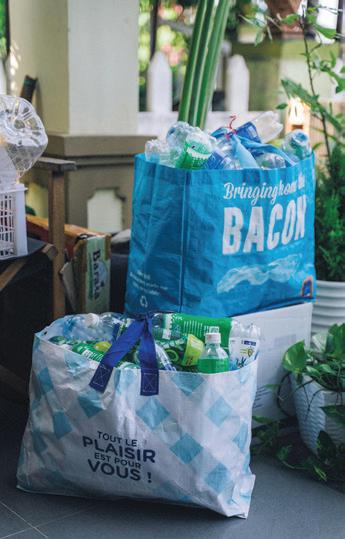
Beverage containers are pivotal in a circular economy as they create a source of valuable recycled material (PET, glass, aluminum, and paper) for markets and generate value across multiple sectors. Whether Ontario's curbside recycling system or the Alberta and Saskatchewan depot system, beverage container recycling has proven its social, environmental, and economic worth in Canada.
Beverage container recycling creates jobs in four main areas: collection and administration, transportation, sorting and bailing, and processing. The process begins by collecting materials from residential areas through curbside programs, drop-off sites, and stewardship management systems. Collected recyclables are transported to processing facilities, sorted and baled based on their type and quality. Finally, secondary facilities process the materials, such as plastic reclaimers, glass beneficiation
plants, and aluminum recycling facilities, before being shipped to end markets. Each of these activities contributes to job creation and economic growth.
In addition to the recycling process, these activities stimulate indirect and induced jobs. Indirect jobs come from the sector's demand for goods and services, such as equipment manufacturing and facility maintenance.
Meanwhile, increased consumer spending by recycling facility workers results in additional economic activity, which induces job creation in other industries.
The residential curbside recycling system in Ontario facilitates the recovery of non-alcoholic beverage containers, creating more than 7,000 direct full-time equivalent (FTE) jobs and more than 5,000 indirect and induced jobs, totalling over 12,500 FTE. Despite the relatively low recovery rate and the increased cost of transitioning to full extended producer
responsibility (EPR), the system benefits from the volume of beverages consumed in Canada's most populated province.
In Alberta, recycling is facilitated through a deposit-return system (DRS) administered by the Alberta Beverage Container Recycling Corporation. With a recovery rate of over 82 per cent, the province is a model for the economic merits of beverage container recycling. Approximately 17 FTE direct jobs are created per 1,000 tonnes of beverage containers recovered from Alberta's DRS program.
When considering absolute employment numbers, beverage container recycling generates more jobs than any other waste type, accounting for 30 per cent of all jobs (direct, indirect, and induced) associated with the province's recycling programs.
Saskatchewan is another excellent example of this in action, with the prairie province using recycling as a force for progressive
employment. Contracted by the Government of Saskatchewan, SARCAN manages the recycling of beverage containers and other materials. In 2021, over 900 employees at SARCAN diverted more than 47 million pounds of material, showcasing the incredible job potential of these innovative programs. Today, there are 73 depots in Saskatchewan employing people of all abilities, making SARCAN one of the largest affirmative employers in Canada.
As we look toward a more sustainable future, investing in and expanding recycling initiatives like DRS will be crucial for both environmental stewardship and economic prosperity in Canada. By continuing to support these programs, we can build a greener economy that benefits everyone.
To learn more about the beverage industry's commitment to sustainability, visit madetoberemade.ca
Everyone eats to survive, but food is much more than just a necessity of life. It’s also a common language across generations, cultures, and languages, bringing people together to share experiences of taste, flavour, and sensation.
Canada's rich heritage attracts people from all over the world to its shores. That includes more than 17,000 international farm workers who come to Ontario every year to work on fruit and vegetable farms as part of the Seasonal Agricultural Worker Program (SAWP).
They hail from Mexico, Jamaica, Barbados, Trinidad and Tobago, and the Eastern Caribbean islands and play essential roles in helping Ontario farmers grow the popular but labour-intensive fruit and vegetable crops popular with consumers.
It can be hard to be away from family and friends for months at a time, and when they’re not on the job, workers keep busy with activities like soccer and other sports, music or cooking for
their friends and co-workers. Errol Mitchell from Jamaica has been working in Ontario annually for more than 16 years through the SAWP, for more than seven of those years at a Southern Ontario greenhouse. “I love to cook, and I love to listen to music… I enjoy cooking for the guys sometimes. I cook and everyone sits and eats,” he says.
Many of the ingredients for tasty and nutritious Mexican, Jamaican or other Caribbean recipes are grown right here in Ontario, giving you an international flavour with local flair. Try these Mexican tostadas featuring locally grown tomatoes, green onions, celery, parsley, coriander, onion and garlic as a quick weekday supper option.









PREP TIME: 15 MINUTES • COOK TIME: 15 MINUTES • SERVINGS: 4
Ingredients
• 4 tomatoes, coarsely chopped
• 2 green onions, sliced
• ½ cup (125 ml) chopped celery
• 1 tbsp (15 ml) chopped fresh coriander or parsley
• 1 tbsp (15 ml) red wine vinegar
• ½ tsp (2 ml) ground cumin
• ½ tsp (2 ml) crushed red pepper flakes
• ½ tsp (2 ml) salt
• 8 corn tortillas
• 1 lb (500 g) lean ground beef
• 1 onion, chopped
• 1 clove garlic, minced
• 1 cup (250 ml) tomato sauce
• 1 tsp (5 ml) chili powder
OPTIONAL GARNISHES:
• Sour cream
• Chopped green onion
Directions
1 In a medium bowl, combine tomatoes, green onions, celery, coriander (or parsley), vinegar, cumin, red pepper




flakes and half of the salt. Cover and set aside.
2 In a small dry skillet, over medium heat, toast tortillas until lightly browned and crisp on both sides. Set aside.
3 In a large nonstick skillet, cook ground beef, onion and garlic over medium heat, stirring and breaking up meat with a wooden spoon, until browned. Drain off any excess fat.
4 Stir in most of the tomato sauce (reserving some for garnish), chili powder and the remaining salt. Reduce heat to low and simmer until thickened, about 5 minutes.
5 To serve, place tortillas on plates and spoon beef mixture evenly over each. Top with a reserved tomato mixture, sour cream, and green onions if you are using them. Serve immediately. —NC













Did you know that your daily meal choices can affect your health, the environment, and the national economy? Hint: October is National Seafood Month!
But here’s the catch: Canadians are not consuming enough seafood. According to a recent survey conducted by the Fisheries Council of Canada and the Canadian Aquaculture Industry Alliance, most Canadians are not eating the two portions a week recommended by Health Canada and the World Health Organization.
From fish and shrimp to oysters and mussels: Seafood offers a bounty of essential nutrients like omega-3s, iron, and vitamins that contribute to strong bones, brain development and healthy hearts and immune systems. Plus, many seafood options are as protein-rich as beef, chicken and pork, making them a valuable addition to a balanced diet.
Canada’s fisheries are leading the way in sustainability, proudly ranking among the top five globally for Marine Stewardship Council (MSC) sustainable fishery certifications. This dedication to sustainable fishing isn’t just about setting
a high bar; it’s about unlocking the enormous potential of our oceans while ensuring they remain healthy and productive. Our fisheries are not just setting standards—they’re redefining them. With 95 per cent of fisheries harvested sustainably and a
continuous push for cutting-edge technology, Canadian seafood is at the forefront of environmental innovation. Canadian companies are deeply invested in developing advanced gear, refining harvesting techniques, and improving processing methods to enhance

sustainability. This ex-squid-sit dedication ensures that we’re not only preserving the environment but also leading the charge in responsible fishing practices. Our world’s oceans hold vast potential. Oceans could sustainably provide over six times more food than they do today, enough to cover more than two-thirds of the animal protein needed to feed the growing global population. By embracing this potential, Canada can set a global example and support a robust domestic blue-foods movement.
As climate champions, seafood boasts some of the lowest greenhouse gas emissions per unit of protein produced—up to 250 times less than beef. Incorporating more seafood into your diet not only benefits your health but also supports Canada’s climate goals by reducing the overall carbon footprint of your food choices. Eating ocean-based foods helps decrease greenhouse gas emissions, making a tangible difference in our efforts to combat climate change.
Investing in sustainable seafood is a win-win. For every dollar spent on sustainable ocean-based protein,
the returns could be as high as tenfold. With the right measures, Canada could double the value and benefits of its seafood industry while increasing domestic consumption. This economic boost also translates into more jobs and a stronger industry that can continue to support both local communities and environmental initiatives. By choosing seafood, you’re making a smart, health-conscious choice while supporting an industry that contributes $9 billion annually to the Canadian economy and promotes environmental sustainability. Embracing seafood as a regular part of your diet helps reduce carbon emissions, supports sustainable practices and ensures the longevity of our ocean’s resources.
So next time you are planning a fin-tastic meal, consider seafood! It’s a win for your health, the environment and our economy.
If you’re unsure where to start with buying and cooking highquality, sustainable Canadian seafood, check out our Seafood Guide at fisheriescouncil.ca/ shopseafood FisheriesCA




In the early years of a child's life, a world of discovery awaits them. From the first time they recognize their parents' faces to the colourful excitement of their first day of school, these moments are captured through the lens of a child's vision. But what happens when that vision is impaired? Enter the optometrists of Ontario—often unsung heroes in the development of young minds—who work tirelessly to ensure that every child sees the world clearly.
At the forefront of this mission is the Ontario Association of Optometrists (OAO) and their remarkable Eye See… Eye Learn® program. This initiative is more than just a vision care program; it’s a lifeline for countless families and a testament to the dedication of optometrists who understand that vision is the gateway to learning and success.
EYE LEARN®
Launched over 20 years ago, the Eye See… Eye Learn® program was created with a singular purpose: to ensure that every child in Ontario has access to comprehensive eye care. The program targets kindergarten-aged children, a crucial period when early detection of vision problems can significantly affect a child’s development and academic journey.
The premise is simple but
powerful. Children enrolled in the program receive a no-cost eye exam from a participating optometrist, and if required, they are also provided with a free pair of high-quality glasses. This removes any financial barrier that might prevent parents from seeking eye care for their children, ensuring that vision problems do not become a roadblock to a child’s learning and overall well-being.
Dr. Jeff Goodhew, a participating optometrist, highlights the impact of the program: “The Eye See… Eye Learn® program has eliminated any financial barriers to parents by providing a complementary pair of high-quality eyeglasses when required. Overall, a great initiative to ensure a child's learning is not impeded by poor vision.”
Last year alone, the program provided over 2,600 pairs of complimentary glasses to children across Ontario. This achievement underscores the program's success in making vision care accessible to all, regardless of a family’s financial situation.
OPTOMETRISTS: THE HEROES BEHIND THE SCENES
Optometrists are often the first line of defence in a child’s healthcare. They play a critical role in identifying vision problems that could otherwise go unnoticed, potentially leading to difficulties
in school and social development.
The Eye See… Eye Learn® program is supported by over 1,100 optometrists across Ontario, each of whom is committed to ensuring that no child falls through the cracks.
Dr. Shaina Nensi, President of the Ontario Association of Optometrists, articulates the importance of this initiative: “Ensuring children's vision health is crucial for their development. Routine eye exams help detect issues early, giving them the best chance to succeed in school and life. Our Eye See… Eye Learn® program is dedicated to making this accessible for all families.”
This program is not just about handing out glasses; it’s about changing lives. Children who struggle with undiagnosed vision issues often face challenges in reading, writing, and participating in classroom activities. By providing early intervention, optometrists are helping to level the playing field for these children, giving them the tools they need to succeed.
WHO IS ELIGIBLE?
The Eye See… Eye Learn® program is available to all children born in 2019 or 2020. Families are encouraged to take advantage of the program, especially since vision problems can be hard to detect in young children. Many children with
vision issues don’t realize that their experience isn’t normal and may not complain about difficulties seeing. This makes it all the more critical for parents to ensure their child receives an eye exam before starting school.
HOW TO PARTICIPATE
Participating in the Eye See… Eye Learn® program is straightforward. Parents or guardians of kindergarten-aged students can book an eye exam with any participating optometrist in Ontario. The eye exam is covered by OHIP, making it free of charge for the family. If the optometrist determines that the child needs glasses, they will be able to choose a pair from a selection of high-quality frames and lenses provided at no cost.
To find a participating optometrist, families can visit the Eye See… Eye Learn® website to find one of almost 500 participating locations.
THE IMPACT: BEYOND THE CLASSROOM
The benefits of the Eye See… Eye Learn® program extend far beyond the classroom. Vision is integral to nearly every aspect of a child’s development, from learning to read to developing handeye coordination. Correcting a child’s vision not only improves their academic performance but also boosts their confidence and social interactions.
The program also serves as a reminder of optometrists' broader role in the healthcare system. These dedicated professionals are not just correcting vision; they are empowering the next generation to achieve their full potential. By identifying and addressing vision problems early, optometrists are helping to ensure that every child has the opportunity to thrive. The success of the Eye See… Eye Learn® program is a testament to the power of community and collaboration. It relies on the commitment of optometrists who go above and beyond to serve their communities and the support of organizations and businesses that provide the resources needed to supply free glasses to children in need.
As the program continues to grow, so too does its impact. With each child who receives an eye exam and a new pair of glasses, the ripple effects are felt throughout the community. Teachers notice improvements in students' performance, parents see their children’s confidence soar, and most importantly, children are given the gift of clear vision—a gift that will benefit them for the rest of their lives. Optometrists may not wear capes, but they are undoubtedly heroes in the eyes of the children and families they serve. And with every pair of glasses they provide, they are helping to shape a clearer, brighter future for all.
